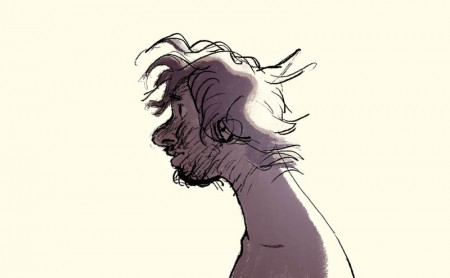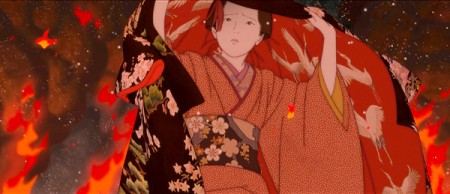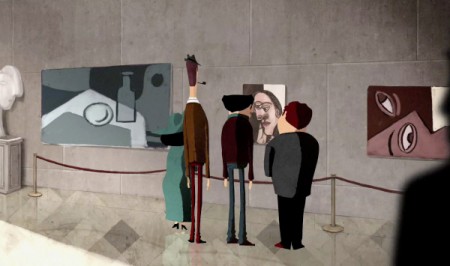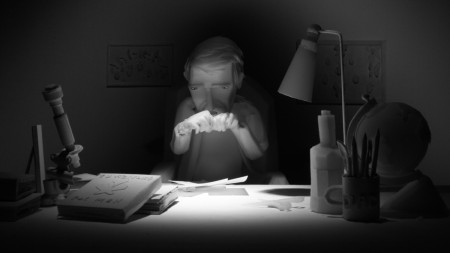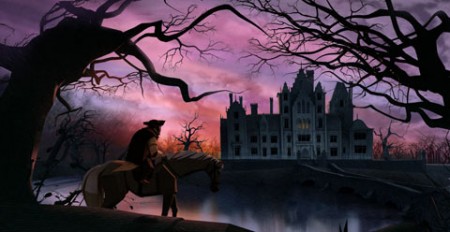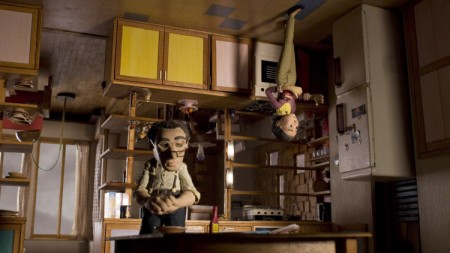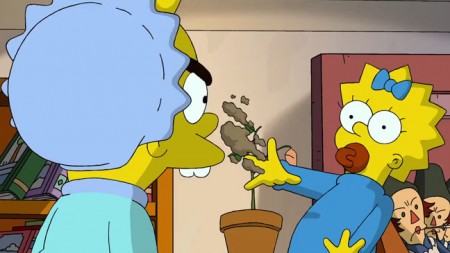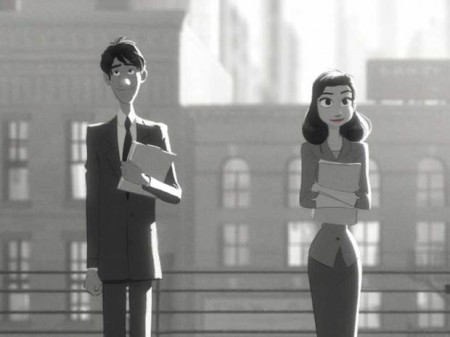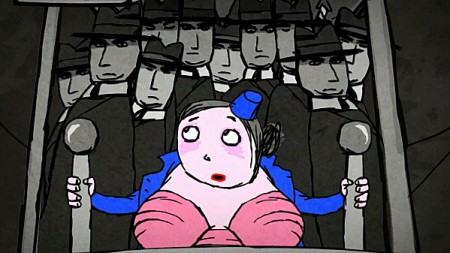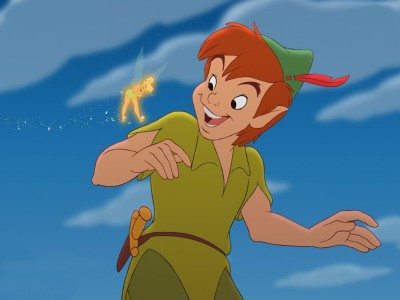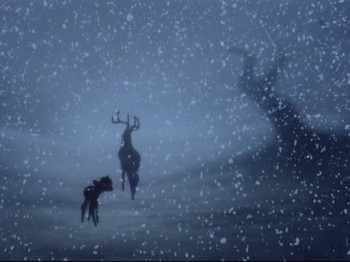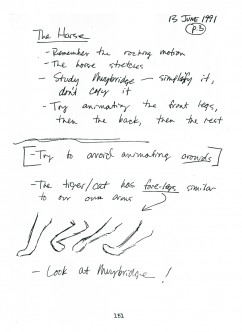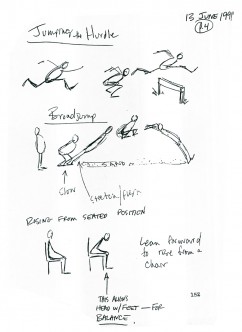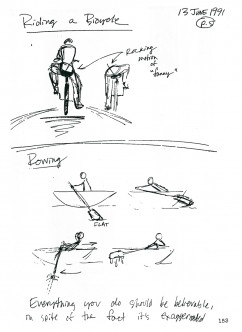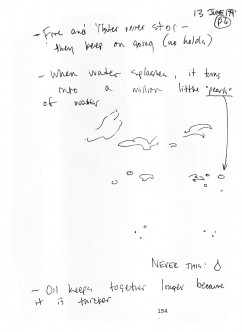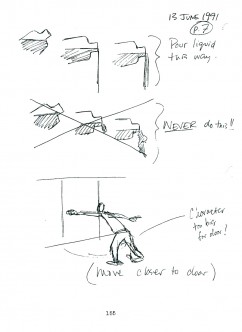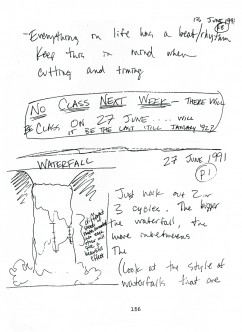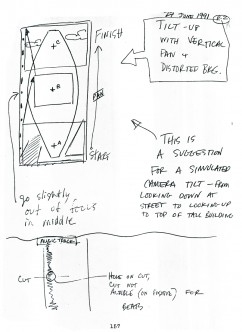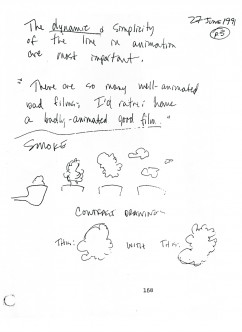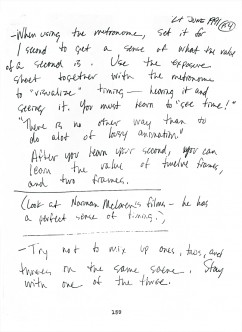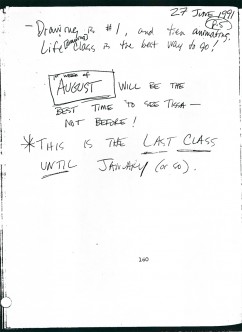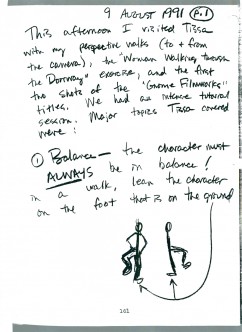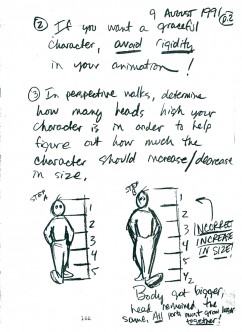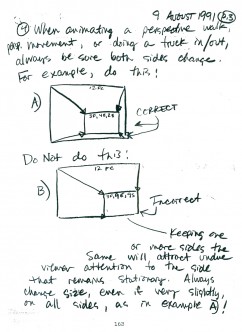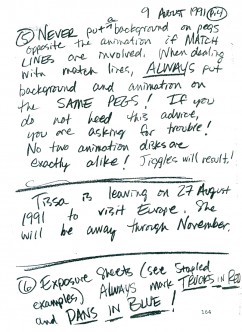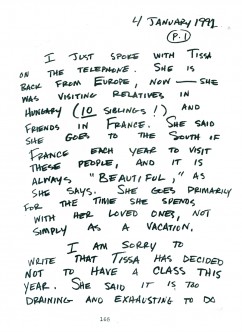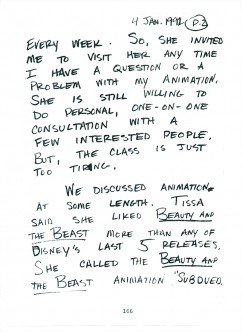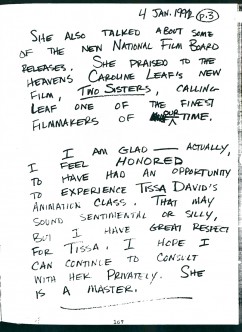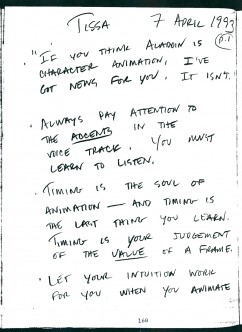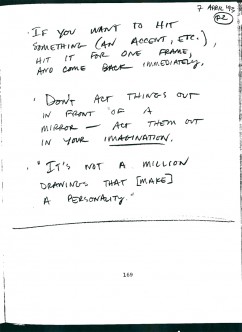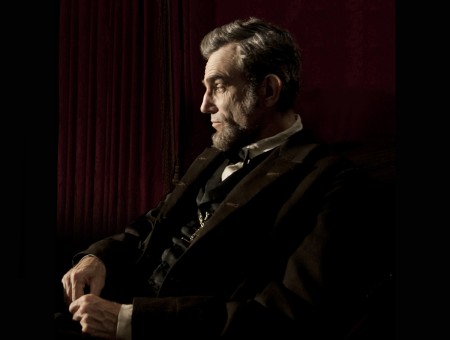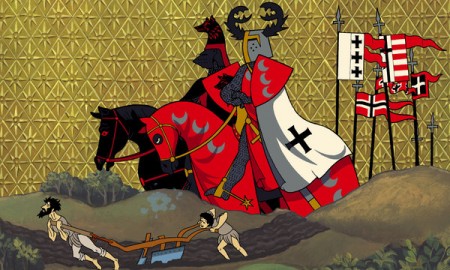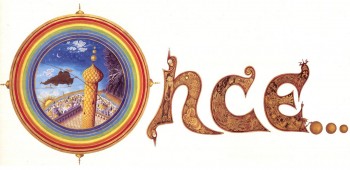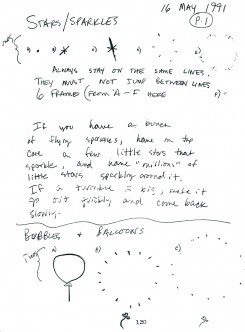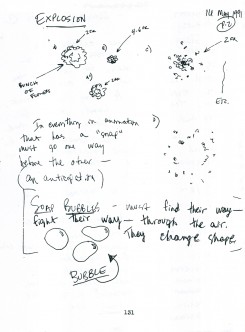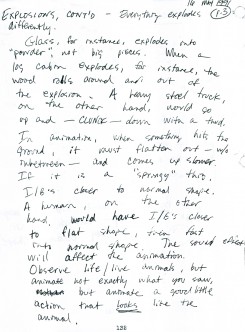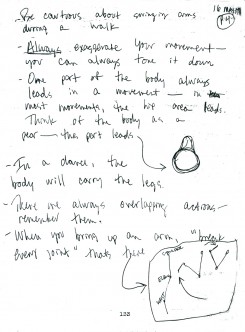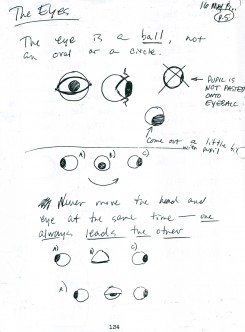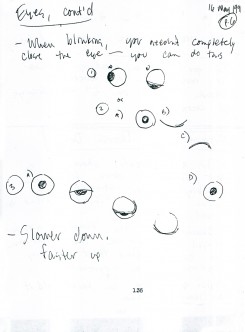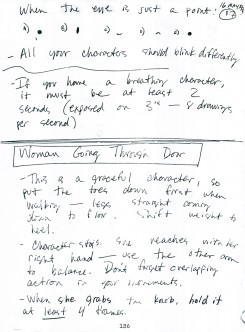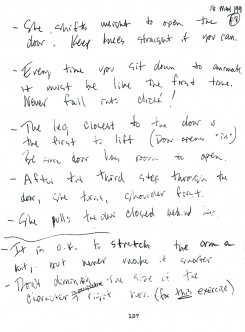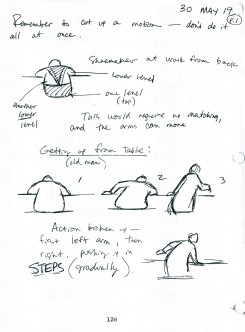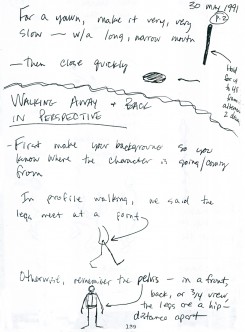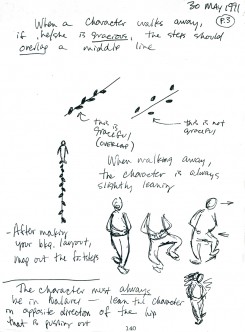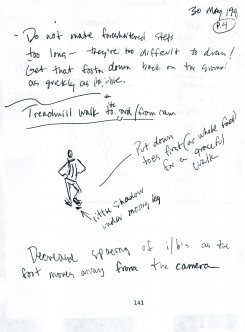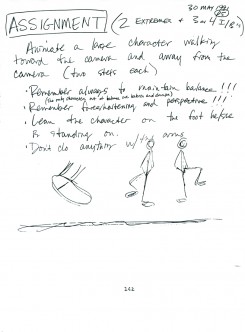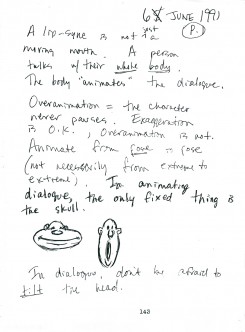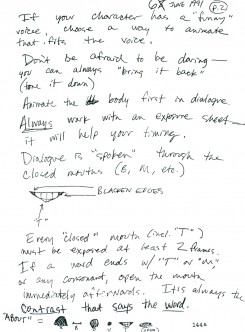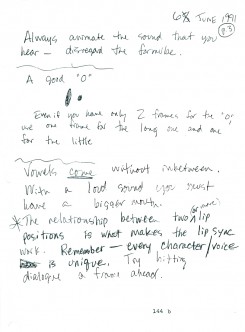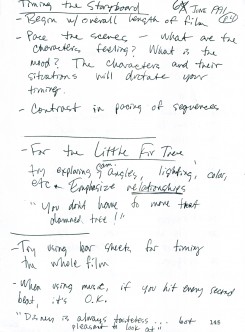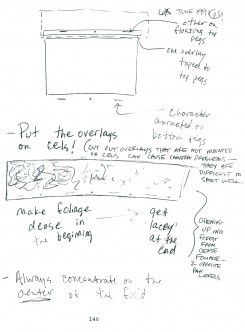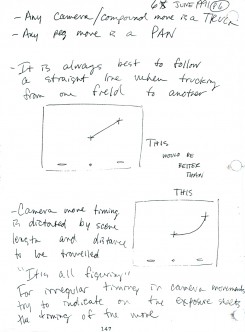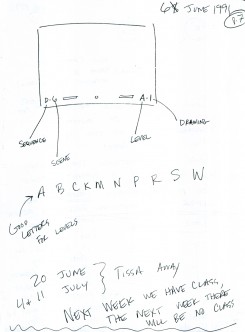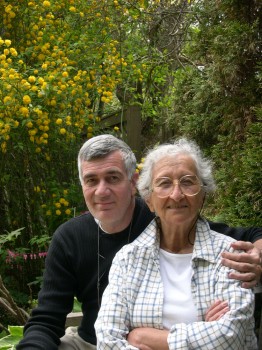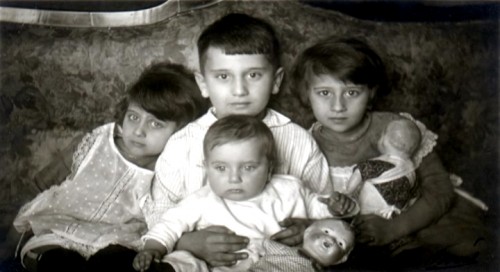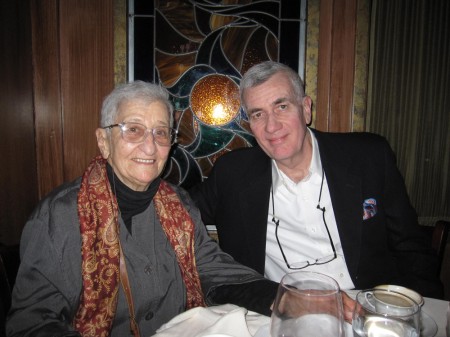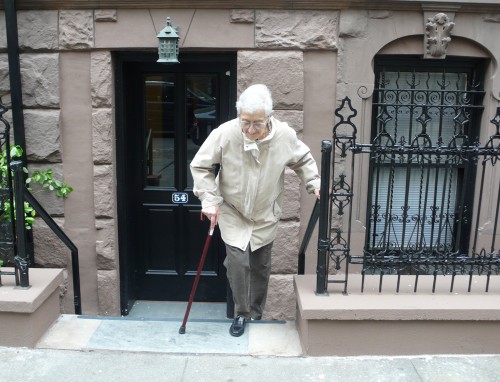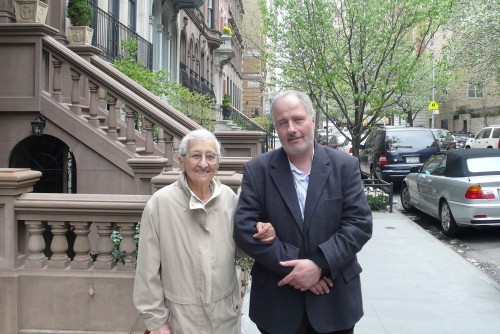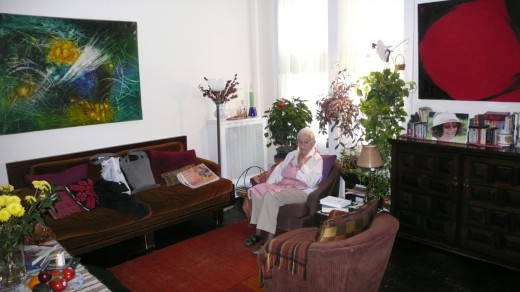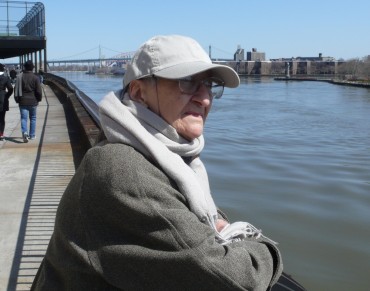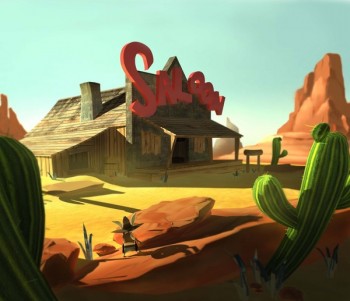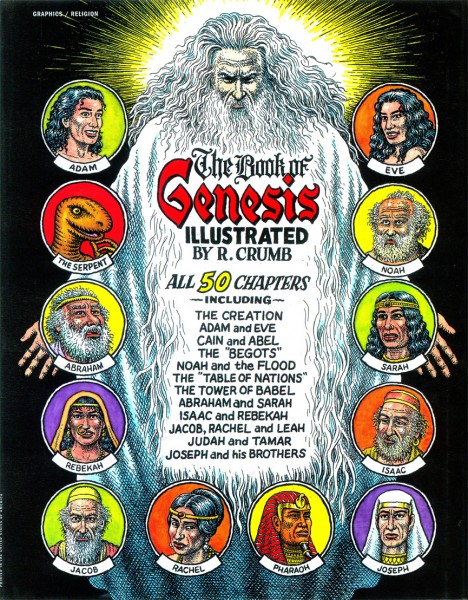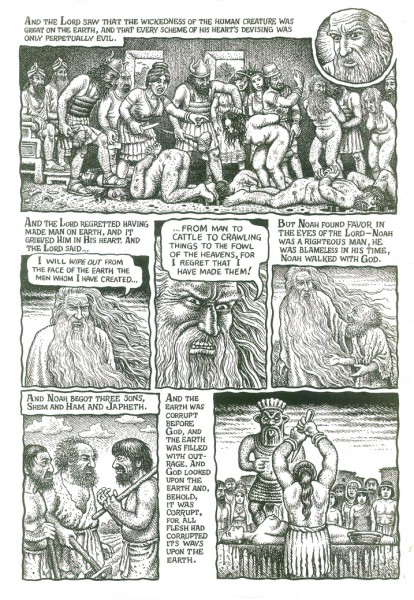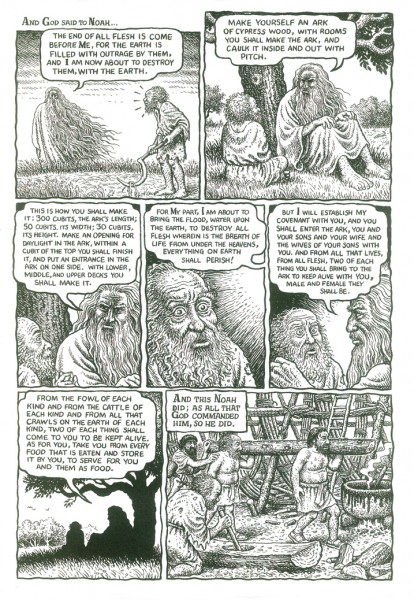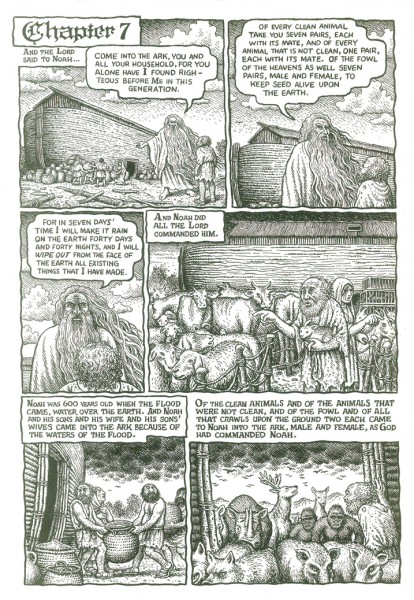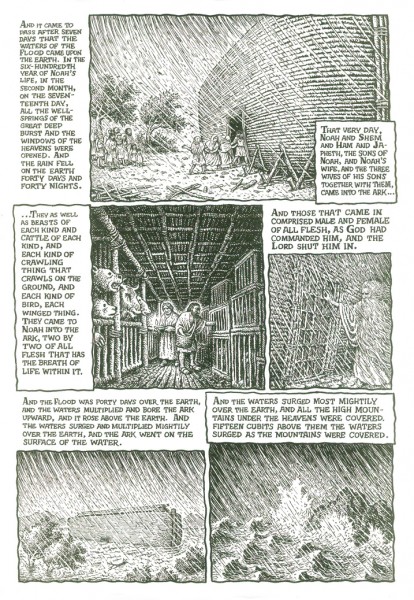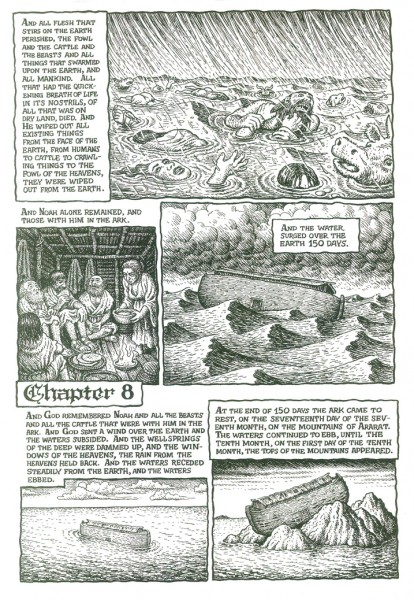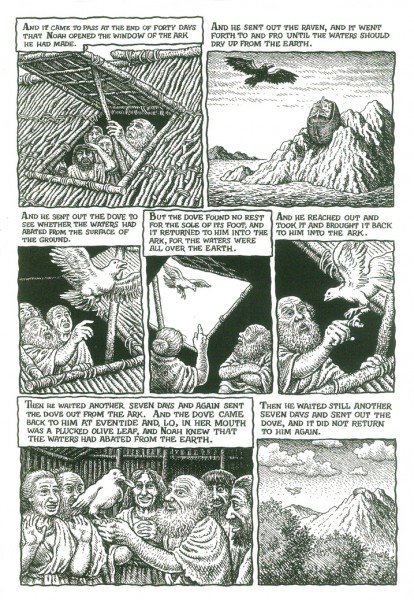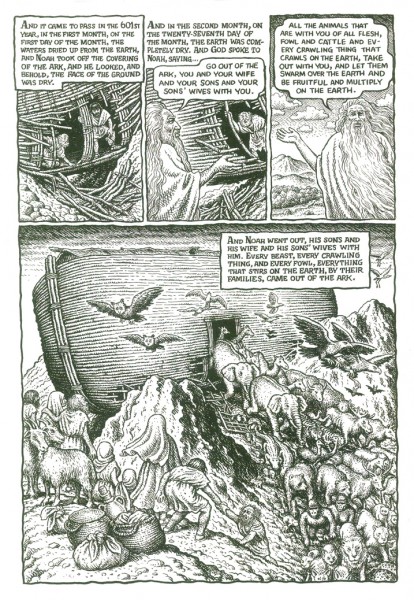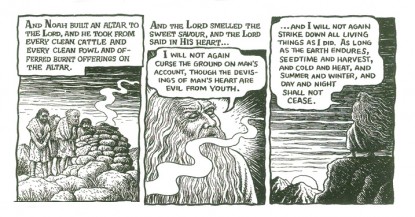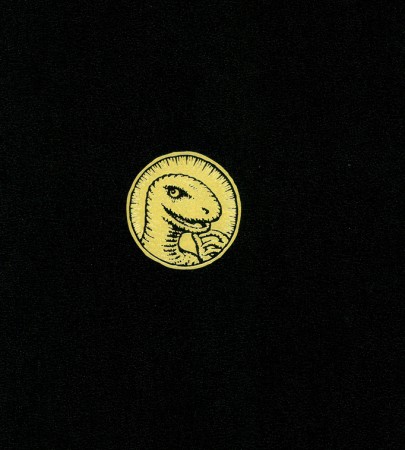Category ArchiveCommentary
Commentary 19 Nov 2012 06:55 am
A Short List
Let’s look a bit more closely at those films which have fallen onto the short list as potential nominees for the Oscar. Of 56 films, ten have been selected for this honor. In the past, this list would never have been released, now it’s part of the process, and a good one, I think. Let’s make the most of the feast.
Back in 1984 when I was nominated, I learned of the nomination the night before the full list of three nominees were announced. Prior to that I had no clue I was even being considered. As a matter of fact, after submitting the film, Doctor DeSoto, I virtually forgot about having entered it. I’d considered it such a ridiculous long shot that I knew there was no chance of it happening.
The nominees have two short periods of glory, and the most has to be enjoyed when you’re on the list. On January 10th 2013, the nominees will be selected. That gives those who are on this list now a good six weeks to cherish the moment. First and foremost, promote yourself and the film. Go out there and let everyone you know hear that you’ve been selected for the list, and seek out every potential way of publicizing the event. Call any local paper and remind them. Getting your name in the Pennysaver is as important as getting it on your own blog. Speaking about blogs, contact everyone you know who has one and make a pest of yourself. This is an opportunity to promote yourself, and you have to take it. God willing, you’ll get to do it all again when you get on the nominee list.
When I was nominated, Entertanment Tonight did no stories on the Best Animated Short. I contacted them so often that they did one (which aired the night of the Awards Show) and they’ve continued to do one every year since. Maybe you can convince TMZ of the importance of the event.
Oh, yes. Back to the list.
These are the ten films that have been selected to move forward from the original list of 56.
Minkyu Lee is a Disney veteran, as are many of the animators who worked on this film; on that took over two years to make. The anmated short takes the Adam and Eve story, allows it to happen off screen, and focuses on a dog who befriends Adam. The character animation is well oned and finely produced, the graphic design is beautiful, and Joey Newman’s music shows his relation to the famous and talented Newman family. The film is a winner, especially, I would guess, in Hollywood where they crave such beauiful animation. Several friends questioned the Christian sub themes, but somehow I missed that as I just watched the animation and movement. It’s a gorgeous old-school film and could do well. It won the “Annie” award last year as Best Animated Short.
Click here to see a clip of the film.
Katsuhiro Otomo, the director of this 21 minute short has a large reputation among Anime directors. His film, Akira, is almost legendary among Japan’s feature length animated films. I find that film’s craftsmanship enormously successful despite the complexity built into just about every single scene. Combustible adds a delicacy to that craftsmanship and a story that, without dialogue, tells a complicated tale. It’s an enormously attractive film and I’d like to know who the audience is that such a short, albeit a long short, obviously has a big budget. The film is a triumph for Otomo, and I rather expected it to show up on this list.
Léo Verrier, the director of Dripped is part of a production company named ChezEddy. The company was created in 2002 in Paris; the in-house animation studio is just a part of the company. The film, Dripped, is the story of an art thief, an artist searching for a style. He eats and breathes the art he steals until, finally, something original comes out of him. The film has often been described as an homage to Jackson Pollack. Romanticizing Pollack’s intentions seems to indicate that art history ended back in the early fifties. Perhaps it’s just that he was a convenient stopping point, but I would think if you’re taking “Art” to another level, it should end with something new and vibrant in THIS film. Perhaps the marriage of 2D and 3D cgi is the medium – the dripped art that the title indicated. Unfortunately, for me the story felt marginally dated, though it is graphically interesting and the telling of the story is arresting.
Go here to see a clip.
Mikey Please, directed this extraordinary 3D stop motion short at the Royal College of Art as a thesis film. Immediately, it was a success on the Festival circuit, ultimately winning BAFTA’s 2011 award as the Best Animated Short. The story is intelligent, the technique feels original (though it reminds me of some of Michel Ocelot’s early films), and the approach is funny. My guess is that this is one to beat on the way to the gold.
Go here to see a clip from the film.
Raul Garcia has been dedicated to teling Edgar Allan Poe stories in cg animation. His first film, The Tell Tale Heart, was a somewhat cheeky effort given that the UPA, James Mason film was a classic of the form. However, Garcia’s short was received very well and won a mass of awards from many International festivals. He’s worked on many international features including Asterix and Caesar, The Land Before Time and The Chipmunks Great Adventure. His work on Who Framed Roger Rabbit brought him into the Disney fold working on a number of their recent features, Beauty and the Beast, Hercules and Fantasia 2000. He left Disney to become a sequence director on numerous non-Disney features. In 2002, partnering with Manuel Sicilia he joined Kandor Graphics which became Kandor Moon with the participation of Antonio Banderas. They produced the Oscar nominated short, The Lady and the Reaper. Both The Tell Tale Heart and The Fall of the House of Usher will be part of the feature, The Extraordinary Tales, the title of the Poe feature.
Click here to see a clip.
The animation artist known as PES has finally made the short list after doing about a thousand tiny films. They’ve all bee stop motion pieces employing odd objects to replace other objects. In “Fresh Guacamole,” a hand grenade, a pool ball, a baseball, dice, a green golf ball, and christmas tree lights all replace the ingredients in the making of guacamole. He’s done other such films as Western Spaghetti. I find his films clever, smart and usually just about the right length. However, after seeing a couple of them, a sameness starts to set in. Go here if you want to see a bunch of them. Usually the Academy goes for short and funny and clever. Possibly a good chance for the nominations. Showtime had financed a number of these shorts, and it looks like Fresh Guacamole was theirs as well. Michael Eisner‘s The Tornante Company has just hired PES to direct Garbage Pail Kids movie. This will be his first feature (and probably his first film over ten minutes.)
See Fresh Guacamole here.
Timothy Reckart directed this clever stop motion 10 minute short film. In it, a man and his wife are obviously at odds with each other as each lives on separate planes. He’s on the floor, and she’s on the ceiling (or is it the other way around?). The film was done at the National Film and Television School in Ireland. It took 11 students about 14 months to complete under Mr. Reckart’s supervision. Timothy Reckart seems to be currently involved with the company Dragonframe.
See a clip from Head Over Heels here
David Silverman, who has been connected with The Simpson’s for many years, directed this short film featuring Maggie, as a theatrical film, just as he directed the theatrical feature a couple of years ago. This short is quite funny in the best way of The Simpsons’ television show. I’m not sure it goes very far beyond the best of the TV show, but it is funny. I hope it’s also an indication that there may be another Simpson’s feature in the mix. The last one was a real treat, and it’d be great to see it go into production NOW when the material is still relatively fresh.
See the trailer for The Longest Daycare, here.
I first saw Paperman at a screening of Snow White and the Seven Dwarfs at the recent NY Film Festival. There I briefly met John Kahrs, who seemed nervous but proud of his excellent effort. The film is an odd combination of 2D flat animation and 3D cgi. I feel like I’m missing something whenever they describe what they’ve done. It seems like they animated in cgi, flattened the art and rotoscoped it placing some hand-drawn bits over the cgi bits (such as hair).I’m not quite sure why it wasn’t just animated flat; there doesn’t seem to be anything THAT special about the movement that couldn’t or wouldn’t have been done with any of the good 2D animators they work with. But as I say, I must be missing something. As it is, the film is nice with a great musical score by Christophe Beck, who previously had done The Hangover, Cedar Rapids and The Muppets – all fine scores.
The clip for Disney’s Paperman can be see by clicking here
Michaela Pavlátová is a Czech director who worked in France for Screbleu Productions. The film won the Cristal Award at the recent Annecy Animaton Festival. I’s the story of a tram operator who has numerous sexual fantasies while piloting her vehicle. The animation is bouncy fun, as is the musical score. It’s a light film that would have offended me had the director been a male. As it is it just seems dated to me in its sexual override. But those are just my prurient thoughts on the movie. Not quite grown up.
Watch a clip from Tram here.
Commentary &Daily post 17 Nov 2012 07:44 am
Notes worthy
Hans Perk has begun posting the animator drafts to Disney’s Peter Pan on his blog, A Film LA.
Interesting, the timing. My wife, Heidi, is preparing to direct a version of Peter Pan for and starring school children, and, consequently, the music has been well played in our house these recent days. Quite a great score. (Some of the lyrics have been altered by Disney for PC reasons: “What made the RED man RED” has become “What made the BRAVE man BRAVE.” Hearing a few of the songs has led me to the CD score of the actual film music by Ollie Wallace. what a brilliant composer he was.
I couldn’t be more grateful to Hans for these documents, the drafts. It’s fun to scour the documents and gill in the blanks of who did what bit of animation. (Does anything like this exist in cgi world? Is there some kind of draft that will tell us who the animators are?) I also take some enjoyment from the light bickering that goes on in the coment section of the blog, as people begin to read these drafts and try to discern which characters were assigned to which animators. As Hans comments, it’s nice to take note that Norm Ferguson did his last bit of Disney animation on this feature. He was such an enormous force among the early animators, it was sad to see him burn out the way he did. Though I guess the same could be said for Freddy Moore.
Anyway, Thank you, Hans.
a new Yo La Tengo vid
- Here’s Yo La Tengo‘s latest song and a video. It’s all in the family – Art, I mean.
Emily Hubley did the video for the band with Georgia Hubley, Ira Kaplan and James McNew behind the music.
From the upcoming album “Fade”, out January 14(UK)/15(US)
and available for pre-order: here.
It’s a great number; I can’t stop playing it. I’m looking forward to the album.
GHIBLI on Screen
Currently, playing in New York – and not getting much attention – is a retrospective of the Ghibli films. This has already begun playing and will continue into the next week. You still have time to see the following films:
Castle in the Sky
Japan, Hayao Miyazaki, 1986, 124 min
Mon Nov 19__ IFC CENTER_____12:20PM
Thu Nov 22___ IFC CENTER_____12:20PM
My Neighbor Totoro
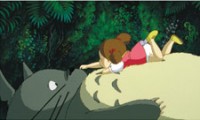 Japan, Hayao Miyazaki, 1988, 86 min
Japan, Hayao Miyazaki, 1988, 86 min
Sat Nov 17___IFC CENTER______3:15PM
Sun Nov 18___IFC CENTER_____12:50PM
Mon Nov 19__ IFC CENTER_____10:40AM 7:40PM
Tue Nov 20___IFC CENTER______3:15PM
Wed Nov 21__IFC CENTER_____12:50PM
Thu Nov 22___IFC CENTER_____10:40AM 7:40PM
Nausicaä of the Valley of the Wind
Japan, Hayao Miyazaki, 1984, 116 min
Sat Nov 17__IFC CENTER_____1:00PM 7:45PM
Sun Nov 18__IFC CENTER____10:40AM 5:05PM 9:50PM
Mon Nov 19__IFC CENTER____2:50PM 9:30PM
Tue Nov 20__IFC CENTER_ ___3:15PM 1:00PM 7:45PM
Wed Nov 21__IFC CENTER____3:15PM 10:40PM
Thu Nov 22_IFC CENTER___ __3:15PM

Princess Mononoke
Japan, Hayao Miyazaki, 1997, 134 min
Sat Nov 17__IFC CENTER____5:05PM
Tue Nov 20__IFC CENTER____5:05PM
Wed Nov 21_IFC CENTER_ ___9:50PM
Thu Nov 22__IFC CENTER____9:30PM
Spirited Away
 Japan, Hayao Miyazaki, 2002, 124 min
Japan, Hayao Miyazaki, 2002, 124 min
Sat Nov 17__IFC CENTER_____10:40AM 10:00PM
Sun Nov 18__IFC CENTER_____2:35PM 7:25PM
Mon Nov 19___IFC CENTER____5:10PM
Tue Nov 20__IFC CENTER_____10:40AM 10:00PM
Wed Nov 21_IFC CENTER______2:35PM 7:25PM
Thu Nov 22__IFC CENTER___ __5:10PM
Imamura Docs
 - I’m a big fan of Shohei Imamura‘s films. Yes, I love Kurosawa and Mizoguchi and Oshima, but I feel more of a kinship to Imamura.
- I’m a big fan of Shohei Imamura‘s films. Yes, I love Kurosawa and Mizoguchi and Oshima, but I feel more of a kinship to Imamura.
A NYTiimes piece by Mike Hale alerted me to the scheduled mini-fest of documentaries by the great director. The films will be screened at the Anthology Film Archives.
I’ve touched on his work before and have written about him in those posts. How could I not, he brings out the artist in me (if, in fact, there is one.) Back in 1979, I stumbled upon a major retrospective at the Japan Society in NYC in 1979. They were about to screen all of his films – two a night – in a complete program of all his work to that point. That meant he hadn’t done Black Rain (1989), The Ballad of Narayama (1983), or The Eel (1997) – three of his greatest. After seeing the first double-bill I was there every Monday – the opening night of each newly screened films – many of them US premieres. Most of the films, to that point, were done in B&W, but the themes were all brilliantly colorful. The weak and corrupt men, the violence, the strong women (the backbone of japan in Imamura’s eyes). They were all there from the beginning, but they grew in depth as the director grew in experience. The films added up to a strong portrait of Japanese society.
Whereas Kurosawa is a poetry of beautiful imagery, Imamura is a prose of themes, imagery, sounds and hand-held camera. He sarted as a “B” movie director, and like Don Siegel or Sam Fuller or Edgar Ulmer. He was part of the Japanese “New Wave” eracting against the slick studio flms of the time, in particular the style of Yasujirô Ozu. There’s a grit to his work, and very much like the theme of his films. The brutish male refined by that female backbone. He’s a master and I’m looking forward to seeing these documentaries.
A Newer Recobbled Cut
Garrett Gilchrist is assembling another cut of Dick Williams’ would-be-masterpiece, The Cobbler and the Thief. The first fifteen minutes are up and running and can be found embedded, below. It really does feel more finished.
The Thief Archive is Garrett’s YouTube site for all things Richard Williams.
Kickstarter
A number of people have recently asked me to promote their Kickstarter campaigns to raise funds for their movies or projects. I’ve turned down most of them and will continue that policy. There are too many going after funds, and I don’t have enough interest to support everyone with space on this Splog. It would end up making the contents of the posts dull, at least for me.
But there’s the occasional film in process that excites me.
- Uli Meyer‘s film version of Ronald Searle‘s the animated Bells of St. Trinian’s excited me. They hadn’t yet started their Kickstarter campaign, but I was ready to promote them full out. Unfortunately, they’ve had a setback and their project is on hold, as is their fund raising campaign.
- Mark Sonntag‘s film Bounty Hunter Bunny will be a challenge. I like Mark’s blog Tagtoonz, I like the film he’s proposing, and I like Mark. Given such, I will support his Indiegogo campaign as much as is possible.
- Then, this week I was approached by Fumi Kitahara about Pamela Tom’s proposed documentary, Tyrus Wong: Brushstrokes in Hollywood. Wong, of course, designed Bambi, one of my all-time favorite films, nevermind animated films. Wong is 102 years old, and I want to see him talk, paint, breathe. If there’s a chance this film will capture that, and I feel pretty confident that will happen, then I want to see the film made. Yes, I support this film. The documentary has been in the works for the past twelve years, and I would like to see it completed. Hopefully, this Kickstarter campaign will make it happen. Tale a ;ppk, and read their proposal.
Running in Place
For the past week I think I’ve been endlessly running. Running from screening room to screening room. A lot of movies to see before December is over. I should bypass them all for the blog, but I started doing this recently, so I want to continue. Even if I have to boil some of the films down to a word or three. Next week, there’ll be a couple of animated films, so it’ll get more pertinent then, but for now, let me tell you what I’ve seen. By that I mean movies.
Sunday, last week, started off with a wierd double bill including two parties. First there was a film starring Elle Fanning. Ginger and Rosa was, sort of, a love story between two young women. Girls, really, in England. Ginger (who had ginger colored hair, of course) and Rosa (who had darkish colored hair) were the closest of buddies. At least they were until Rosa fell in love with Ginger’s father, and she betrayed their love. The real surprise was at how tall Ginger . . . er, Elle Fanning was. She was just a smidgen taller than I. The tallest female I’d seen since seeing Keira Knightley in person last week. She’s almost five inches taller than I and she’s also incredibly thin. Whereas Keira is charming almost to a fault, Elle is as shy as you might suspect.
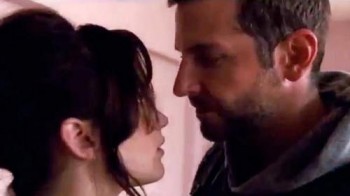 The second film that night was Silver Linings Playbook. This was a fabulous film directed by David O. Russell, who got enormous credit for his film two years ago, The Fighter. But this is the good one. An absolute delight with a great after party. But Harvey Weinstein always has the best parties. At a great and expensive place. No animators there but lots of celebrities and great food. That was a wonderful start for the week; the end of the weekend.
The second film that night was Silver Linings Playbook. This was a fabulous film directed by David O. Russell, who got enormous credit for his film two years ago, The Fighter. But this is the good one. An absolute delight with a great after party. But Harvey Weinstein always has the best parties. At a great and expensive place. No animators there but lots of celebrities and great food. That was a wonderful start for the week; the end of the weekend.
Monday brought another film, Anna Karenina. This was the film that had the luncheon the Thursday before. What a sumptuous delight, the movie. It’s supposed to take place in a theater, but the film broils over with Russian delight. Lots of waltzing camera moves and rich visuals. The camera danced all movie long in the tale of passionate infidelity as the cast pulsated with theatrical emotion led by the Tom Stoppard screenplay. A thousand page novel clocks in at just over two hours with more swooning temperament than can be found anywhere in real life. The director of Pride and Prejudice, Joe Wright, doesn’t quite pull off the emotional ending, but leaves you dumbfounded by the rich splendor on screen throughout his movie.
Tuesday was led by a lunch with Ang Lee celebrating The Life of Pi. Ths is the film I’m desperate to see, yet have only been available, so far, for the celebration. John Canemaker and I ate at the table with several of those who were marketing the film, so we learned a lot abot the making of the movie. The had also just shot an interview with Charlie Rose and were full of talk about that chat. The food at Michael’s was great. . . cod.
 Tuesday evening two movies. The Persecution . . . I mean Prosecution of an American President was a political screed trying the former President, G.W.Bush, for War Crimes. Needless, to say the movie found him guilty. I didn’t sleep through ALL of it, though I tried. Ths led into Skyfall, the new James Bond film. Tis was good, but it was more action-adventure than Romantic-Action Adventure. In short the sex and the laughs were drained from the movie. Not quite your father’s James Bond, more like the teenager’s movie.
Tuesday evening two movies. The Persecution . . . I mean Prosecution of an American President was a political screed trying the former President, G.W.Bush, for War Crimes. Needless, to say the movie found him guilty. I didn’t sleep through ALL of it, though I tried. Ths led into Skyfall, the new James Bond film. Tis was good, but it was more action-adventure than Romantic-Action Adventure. In short the sex and the laughs were drained from the movie. Not quite your father’s James Bond, more like the teenager’s movie.
 Wednesday evening brought a date with Mrs. James Bond, Rachel Weisz. She starred in the Terence Davies movie adaptation of the Terence Rattigan play, The Deep Blue Sea. Like all Davies movie, very claustrophobic, very British film wherein the cast usually finds themselves singing in the local pub. I love it, though it really is very slow-moving and insular for most people. The Q&A afterward had the stunningly attractive Ms. Weisz showed us how regular a person she is. The final question from the audience, of course, was, “. . . how does it feel to be married to James Bond?” “Wonderful,” was the answer she shot back. “How do ou deal with all the posters of your husband all over NY?” “I don’t notice them. I see more of them in my mind than are really there.” Ah, true love. Her movie was about guilt ridden infidelity in the fifties.
Wednesday evening brought a date with Mrs. James Bond, Rachel Weisz. She starred in the Terence Davies movie adaptation of the Terence Rattigan play, The Deep Blue Sea. Like all Davies movie, very claustrophobic, very British film wherein the cast usually finds themselves singing in the local pub. I love it, though it really is very slow-moving and insular for most people. The Q&A afterward had the stunningly attractive Ms. Weisz showed us how regular a person she is. The final question from the audience, of course, was, “. . . how does it feel to be married to James Bond?” “Wonderful,” was the answer she shot back. “How do ou deal with all the posters of your husband all over NY?” “I don’t notice them. I see more of them in my mind than are really there.” Ah, true love. Her movie was about guilt ridden infidelity in the fifties.
Animation &Animation Artifacts &Commentary &Guest writer &Tissa David 15 Nov 2012 08:05 am
Tissa’s Class – part 6
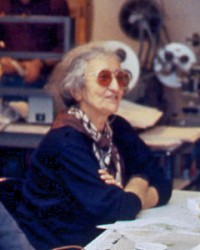 - From 1991-1992, Tissa David, taught a class in animation which was open to anyone who wanted to attend. R.O. Blechman offered his studio, The Ink Tank for a loction where the classes were held after hours. Those who worked in the day could attend the evening sessions..
- From 1991-1992, Tissa David, taught a class in animation which was open to anyone who wanted to attend. R.O. Blechman offered his studio, The Ink Tank for a loction where the classes were held after hours. Those who worked in the day could attend the evening sessions..
Eugene Salandra, a talented young animator, took notes in the classes, and recently I’ve been posting those notes here, with his permission. Some of the lessons seem a bit dated since they were done for 2D animation which was shot under a camera. However, all of the notes are important since learning the information will help you understand the proper use of the “camera” even if the camera is a computer.
Unfortunately, this is the last of the notes. Eugene also did tighter notes which were more cleaned up, and I may post those as well. I have to read them all before I decide one way or the other.
You can see the earlier parts by going to these links:
____________________________________part 1, part 2, part 3. part 4, and part 5
Here is part 6:
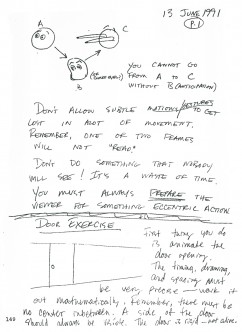 49
49 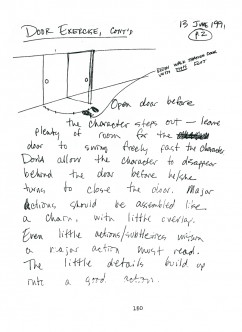 50
50(Click any image to enlarge so as to be legible.)
Commentary 11 Nov 2012 06:00 am
Lincoln
KNZJAH59VWUM
- I’m a sucker for silent movies. I think I’ve read at least a dozen biographies of D.W. Griffith, and I’ve seen a lot of his films (probably all of the features) at least once. I’m impressed with the drive and the love those people put into their work. They didn’t think of it as an art form, and they weren’t considered artists in their time. But in the end, there can be no doubt that some of the filmmakers of the time were creating art.
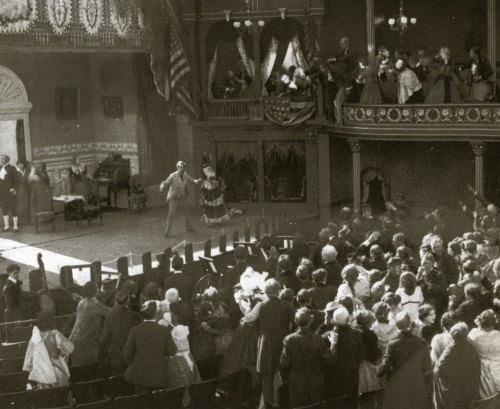
A scene from Griffith’s The Birth of A Nation. It’s a recreation of
Ford’s Theater as Lincoln gets shot.
I once saw a silent feature with no musical accompaniment. The silence was deafening. It was amazing how silent the audience remained throughout the feature film. I guess the film was absorbing enough to make that audience unaware of the silence. That was about 15 years ago; I wonder if the same would occur today.
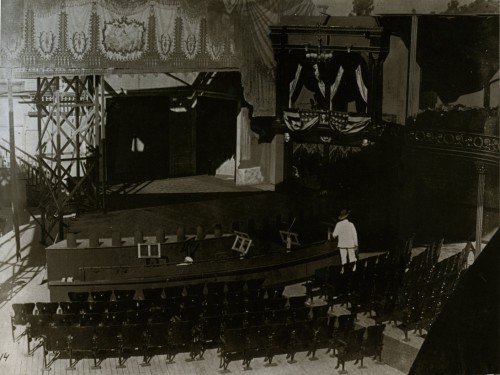
DW Griffith on the Booth Theater set under construction.
Watching silent films with organ music playing background is not the ideal way to see them. 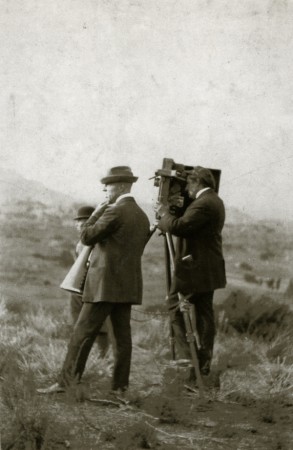 Most piano players who back up these films also aren’t really up to the task. But when you see a film with a great pianist or a good orchestral score it makes all the difference. There’s a musical group called the Alloy Orchestra that enhances the films they accompany, and allows the movies to live up to their full potential. I suggest you try to attend one of their programs if they’re in your neighborhood. (Or just buy one of their cd’s; you won’t regret it.) I suggest Metropolis or one of their sampler albums.
Most piano players who back up these films also aren’t really up to the task. But when you see a film with a great pianist or a good orchestral score it makes all the difference. There’s a musical group called the Alloy Orchestra that enhances the films they accompany, and allows the movies to live up to their full potential. I suggest you try to attend one of their programs if they’re in your neighborhood. (Or just buy one of their cd’s; you won’t regret it.) I suggest Metropolis or one of their sampler albums.
To the left, a rare picture of D. W. Griffith and Billy Bitzer on location for Biograph around 1912. Bitzer is lining up a shot through ground glass, which he has inserted into the gate — there was no viewfinder on the Mutograph camera. This large machine, which punched its own sprocket holes, was smaller and more portable than Biograph’s first cameras. Negatives made with it are still providing superb quality prints.
________(Click any image to enlarge.)
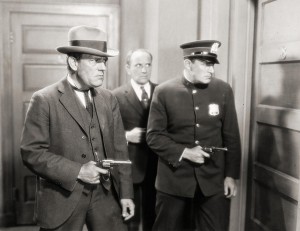 One story from the book Adventures with DW Griffith by Karl Brown has stuck with me for many many years. He and Griffith both lived near 14th Street. Daily they’d walk together to the studio on 125th Street, walking through Central Park. Brown said he once talked about how dangerous it could be walking so early in the morning. At that point, Griffith pulled a long nosed pistol out of his inner jacket pocket, and told Brown he was prepared for any event. This made me realize how volatile a society they must have lived in that early in the century. Thank god times have changed.
One story from the book Adventures with DW Griffith by Karl Brown has stuck with me for many many years. He and Griffith both lived near 14th Street. Daily they’d walk together to the studio on 125th Street, walking through Central Park. Brown said he once talked about how dangerous it could be walking so early in the morning. At that point, Griffith pulled a long nosed pistol out of his inner jacket pocket, and told Brown he was prepared for any event. This made me realize how volatile a society they must have lived in that early in the century. Thank god times have changed.
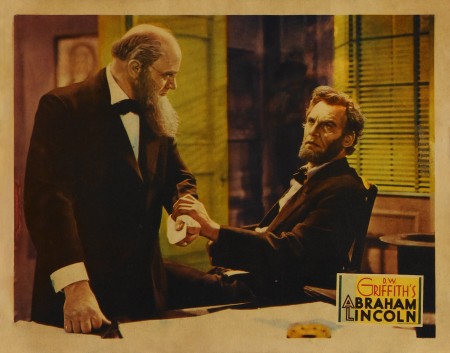
DW Griffith was obsessed with Lincoln and did a number of films that featured the 16th President. One of Griffith’s last films was an early talking film called, Lincoln. It starred Walter Huston (John Huston‘s father) as the President.
Spielberg Lincoln
Spielberg has a new film, Lincoln, in theaters, now. Take a look at the picture of Daniel Day Lewis, above. It may as well be a penny. Incredible, the makeup. Lewis got me even before I saw this film. The voice – what he did with his voice – just took my breath. He
 spoke throughout the film in a higher register than was natural for him. The expected dulcet tones and stentorian readings were not there – on purpose. I keep wanting to say a Nebraskan accent, but that’s wrong. It has to be Illinois, the accent. Daniel Day Lewis obviously worked his voice off for this one, and it’s just amazing.
spoke throughout the film in a higher register than was natural for him. The expected dulcet tones and stentorian readings were not there – on purpose. I keep wanting to say a Nebraskan accent, but that’s wrong. It has to be Illinois, the accent. Daniel Day Lewis obviously worked his voice off for this one, and it’s just amazing.
The brilliant makeup nowadays was expected, but it’s only the acting under the makeup that could pull it off. Stick a lot of makeup on James Caan, and you still have James Caan in makeup. But Daniel Day Lewis knows how to act beyond the mask outside his head, and that performance is astounding. (No, it’s not better than what Jean-Louis Trintignant has done in Amour, both performances are formidable.)
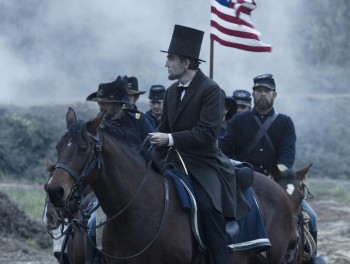 For the first half hour of the movie I was astounded. Everything melds so well together and moves seamlessly in a wonderful recreation of historic Lincoln in the White House of the era. Daniel Day Lewis has you searching the screen for him in every scene. He’s remarkable. Spielberg makes us feel Private Ryan, Gone With the Wind, Birth of a Nation and all of movie history; what a glorious feeling. But the film gets down to business and unfortunately the 2½ hour movie feels rushed. A lot was undoubtedly cut out and consequently the film feels smaller than it is. The story is basically about politics. Getting a vote across in a lame duck Congress. (Great idea for a story.) But you want more – or at least, I did, and I’m sure it was once there. They just took it out to get the film down to a reasonable length. Our loss and the movie’s loss; it makes the movie smaller.
For the first half hour of the movie I was astounded. Everything melds so well together and moves seamlessly in a wonderful recreation of historic Lincoln in the White House of the era. Daniel Day Lewis has you searching the screen for him in every scene. He’s remarkable. Spielberg makes us feel Private Ryan, Gone With the Wind, Birth of a Nation and all of movie history; what a glorious feeling. But the film gets down to business and unfortunately the 2½ hour movie feels rushed. A lot was undoubtedly cut out and consequently the film feels smaller than it is. The story is basically about politics. Getting a vote across in a lame duck Congress. (Great idea for a story.) But you want more – or at least, I did, and I’m sure it was once there. They just took it out to get the film down to a reasonable length. Our loss and the movie’s loss; it makes the movie smaller.
There’s a brilliant scene where the exhausted Lincoln, toward the film’s start, goes into his office. His son (I originally thought it was his daughter, but I was corrected) is lying asleep on a newspaper. (The scene of him on the floor is beautifully done and feels as thogh it’s an outtake from Gone With the Wind. Beautiful in every possible way, and it brings us back to another great Civil war movie.) Lincoln lies down beside him on the floor and embraces him. He wakes up and climbs onto dad’s back and Lincoln takes him off to bed. S. Epatha Merkerson is a character who enters in the very end of the film. She should have been seen earlier. They certainly reduced her part to nothing (even though it’s a key character to the epic version of Lincoln.) And you know there was more of the character once upon a time. The character doesn’t just enter for two scenes and is gone, not in a script by Tony Kushner. No they had to have cut her character onto the editing room floor.
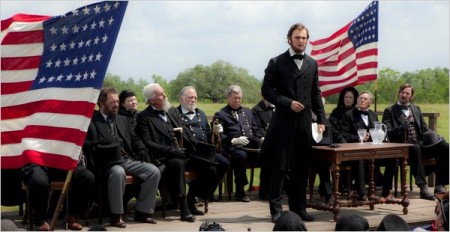
The film needed more breathing room. It’s 2½ hours, and they should have gone for 3. It may have made it a bit stodgy, but it deserved the time. Toward the end it also has too many cherished moments for Spielberg’s romantic side. Lincoln becomes too noble in those beautiful shots, and the music soars in case we missed it. Yet we didn’t need it. A drier film would have been a better film.Still, I’ll see it again. This film should be on a double bill with Spielberg’s Amistad. Then send them both out to the schools of the nation.
See it for all that it is, and all that it should have been. See it for the performances – so many fine ones. See it for the photography. Unfortunately, it’s not the best film of the year. I still don’t know what that is, but this one is not quite an A, maybe a B+ or an A- in my opinion. Great work that was pushed to completion doesn’t always get the full regard.
Since seeing this film three days ago, I haven’t been able to stop thinkng about it. No, not the story, but the actors. The three who try to con the vote out of the opposition, James Spader, John Hawkes and Tim Blake Nelson keep popping up, as does, of course, the incredible Daniel Day Lewis. Even Sally Field is on my mind, particularly in the one scene she, as Ann Todd, argues violently with her husband in their bedroom. I very much want to see the film again. I’d guess that’s a good thing to say for a film.
Tragedy
- To write about another film seems almost blasphemous, but here goes. The NYTimes‘, Robert Ito, writes at length today in a story about Marcell Jankovics‘ new animated feature, The Tragedy of Man. The film took almost three decades to complete and is premiering at the Hungarian Film Festival of Los Angeles on opening night, Nov. 15th. If you live in LA, it sounds like you should be there.
Commentary 10 Nov 2012 12:44 pm
Nor’Easters and other stuff
The following films made the short list for the Oscar’s 10 selections for animation short:
 Adam and Dog, Minkyu Lee, director here
Adam and Dog, Minkyu Lee, director hereCombustible, Katsuhiro Otomo, director
Dripped, Léo Verrier, director here
The Eagleman Stag, Mikey Please, director, and Benedict Please here
The Fall of the House of Usher, Raul Garcia, director here
Fresh Guacamole, PES, director here
Head over Heels, Timothy Reckart, director here
Maggie Simpson in The Longest Daycare, David Silverman, director here
Paperman, John Kahrs, director here
Tram, Michaela Pavlátová, director here
Congratulations to all of those who worked on the films, and my sympathies to those who didn’t make the cut. I liked many of those on the list and liked others not on the list. It’s a crap shoot, sometimes. I’ve been on both sides – those wwho made it and those who were left off. So I know how you all feel.
Animated Feataures & Oscar
Cartoon Brew posted a list of 21 animated features being considered by the MPAA, the Academy, as potentially eligible for nomination. It was pleasing to see that the number has increased, yet it was annoying for another, more personal, reason. As you know I’m an Academy member and voter, and I take great pride in that. I make it my duty to see every film available to me on the big screen, projected. I don’t want to give short shrift to any movie by watching it on the DVDs that they send me. It’s a movie and should be seen as a movie, in a theater with full attention.
This year, the Academy made it harder on us. There are a lot of films to see. Yet, for the second year in a row, the Academy moved up the date of the Oscars and, consequently, the date of when we’d have to vote for the nominees. This year, it basically means that we have to vote by the end of the first week in January. We have to see all the films and vote by then. If you want to see the films on a big screen, it’s hard to do.
I’ve been a judge for a couple of film festivals. (I’m not talking about animation festivals, now.) I was sent dozens of DVDs and had two weeks to see them all and vote. That can be done. You push through a film and if, for any slight reason, you don’t like it, you shut the film and go onto the next. It’s not fair to the movie which may be purposefully gaining strength as it goes on. It’s not fair to any film, really, because that’s your mindset as you turn on the DVD player. It’s not the proper way to watch a movie. You’ll take a phone call and keep talking while the movie runs; you go to the kitchen, get some food and return, eating, while the film keeps rolling. You’re just treating the film like a TV show. Yet, that’s the only way you can get thirty films into two weeks. And you’re judging them!
On to my point. Last year was the first time those on the East Coast were given the opportunity to vote for the nominee list from the group of films that had been proven eligible for Best Animated Feature. Last year there were 18 films and the Academy in NY squeezed out two screenings of each film so we members who were voting could participate. Unfortunately, not a lot of animation members came out for the vote.
This year there are 21 films, per Cartoon Brew‘s list. That’d take a full month to squeeze those screenings in among the many other screenings at the Academy Lighthouse theater. That and, given last year’s low turnout, the decision has been made to cut the vote in New York. To be able to vote for my category, I’d have to move to LA for a month to see the films. I’m bummed about it. Not because I want to see all the mediocre Hollywood fare that’s thrown our way (Rise of the Guardians, for example, is horrible but will probably get nominated) but because there are small gems in among the big films. I think I’ll get to see The Rabbi’s Cat and From Up On Poppy Hill thanks to GKIDS arranging screenings of several of the films they’re representing. That pleases me. But I don’t know if there’s another hidden gem I’ll miss.
I suppose it’s not the Academy’s fault that circumstances aren’t going my way. I love being a member, and I do everything possible to support the best films and the Academy, but I feel left out. Of course I’ve sent a letter of complaint to the board in LA.
The Historicist
OneStop NewsStand is a Canadian news site that includes a weekly column, the Historicist, which is devoted to talking about people who helped shape the city of Toronto. A recent piece focuses on George Dunning and features a number of video clips of Dunning’s films. You might want to take a look at it.
Week in Review
- There weren’t many events I attended to make the week very memorable. Other than the Election. Actually, that was my week. I was up most of that Tuesday night listening to speeches and wrap ups and analyses from those who do so for a living. It wasa all fun, especially since my guys won, and I wanted to savor it as long as I could. Oddly, there never felt like there was much tension involved with it, except for any dirty dealings which could’ve taken place. Too many stories of hundreds of lawyers from both sides at polling stations, made me uneasy. That would be the only way Romney could have won Ohio, and I was made to feel uncomfortable about the possibility of cheating. As it turns out, it didn’t matter. If there was anything crooked, it didn’t affect the final tallies. {Look at Florida. Those corrupt people in power did everything they could to hurt the vote of the underprivileged, and the end result is that even today – two days later – the Florida vote hasn’t been tabulated. The results of all those people having to stand for 4-7 hours waiting to vote, is that the results from that state have been made meaningless to the final number.}
We’d arranged to go to a screening of Spielberg’s Lincoln. This is a film, as I’ve said before, that I wanted to see. However, when Wednesday arrived a Nor’Easter came with it. Rainy snow and heavy winds made it annoying to be outside. So I gave that up and planned to see it on Thursday evening when the Academy had their own screening. This change of plan meant Heidi couldn’t see it (she wasn’t available Thursday) so I’ll have to go again.
I’ve written a longish piece that I’ll post tomorrow, Sunday, about the movie.
Also on Thursday there was a luncheon for Anna Karenina at which the director, Joe Wright, and the star, Keira Knightley, would be in attendance. The meal was at the Waldorf Astoria, so it was a definite place to go if nothing got in the way. As it turns out, Joe Wright was fun and entertaining with stories of making the film, and Keira Knightley was quite charming. She was very tall and very thin and every bit the star. Although she was completely personable and talkative. It was a good luncheon. I look forward to seeing the film which will be screening at the Academy this coming Monday, so there I’ll be.
On Friday there was a screening at School of Visual Arts of a documentary on the making and unmaking of The Thief and the Cobbler. However, the asking price for admission was $16. Sorry, too much for me. I suspect it’s a DVD projection, and I don’t know that it’s worth that entrance fee. Maybe I’ll see it in the future. Since I was involved in the Williams feature, however tangentially, I kinda know the story. It just would have been like reviewing material for me. I can wait.
Oh yeah, there was a Nor’easter this week. It didn’t really have much affect in NYC. There was a light and wet snow that left about an inch of snow – a dusting. I didn’t even use an umbrella despite the fact that I went out in it often enough. IIt was cold and nasty and wet. What else is new for NY n the winter.
Animation &Commentary &Guest writer &Tissa David 08 Nov 2012 07:24 am
Tissa’s Class – Part 5
 - In 1991, Tissa David taught a class in animation for free, open to anyone who wanted to attend. This was sponsored by R.O. Blechman out of his studio, The Ink Tank. It was held after hours, so that those who worked in the business could attend.
- In 1991, Tissa David taught a class in animation for free, open to anyone who wanted to attend. This was sponsored by R.O. Blechman out of his studio, The Ink Tank. It was held after hours, so that those who worked in the business could attend.
The talented animator, Eugene Salandra, kept key notes of the classes, and with his permission, I’ve been posting those notes here. Some of them seem a bit dated these days since they were done for 2D animation that was shot under a camera. However, all of the notes are completely relevant since learning the information will help you understand the proper use of the “camera” even if the camera is a computer.
You can see the earlier parts by going to these links:
_____________
____________________________________part 1, part 2, part 3. and part 4
And, here’s part 5:
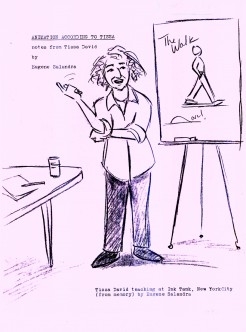 1
1 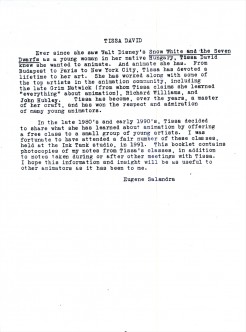 2
2I repeat these first two pages.
(Click any image to enlarge.)
To be concluded next Thursday
Many thanks to Eugene Salandra
Commentary &Tissa David 05 Nov 2012 07:27 am
Speeches
At the memorial service for Tissa David five people gave speeches. I have some of those talks and am posting them here. I also have some photos that I’ll post with them. The photos are identified at the end of the post.
The entire evening was hosted, essentially, by Tissa David, herself. A 90 minute video shot at NYU has Tissa talking about her career and animation, in general. I’ve chosen a lot of clips from this video. Our entire program starts with Tissa talking to the audience about her love for animation. Short clips then precede every section of later film clips screened, and the very last word of the evening is also Tissa’s.
John Canemaker was the first speaker:
- Sunday in the Park with Tissa.
I walk across Central Park at noon to Tissa’s residence on East 83rd Street, a cozy one-bedroom apartment that always smells of baked apples and spices. It’s where she has lived since coming to New York from Paris in 1956; and that’s the year she began working as assistant to master animator Grim Natwick at UPA Studios, then located on Fifth Avenue.
It is a perfect autumn day: crisp and cool, trees in full-color spectrum, bright sunlight. The New York City marathon is in full swing. Barricades, crowds cheering the runners, detours to get you where you need to go. Friendly, happy people everywhere. New York City at its gridlocked best!
Tissa is waiting patiently outside her building, age 90 and ready to go. She wears a white peaked cap, purple/pink sweater and a stylishly long, beige raincoat over wool slacks and shiny black shoes. And she holds a rubber-tipped black cane.
She attended Catholic mass this morning, as she does every day at St. Ignasius Loyola, a church around the corner on Park Avenue run by Jesuits. As is our custom, I lean down to air-kiss one cheek, then the other, saying, “in the European manner.” She smiles and mimics me: “Yes. In the European manner.”
She takes my arm as we walk very slowly toward the Metropolitan Museum of Art two blocks west of her apartment.
She expresses interest in seeing the new Met galleries for “Art of the Arab Lands.†Both sides of her family are Armenian and the rugs of the Arabs stir her, she says.
“Have ever been to Spain?†she suddenly asks.
“Barcelona,†I answer.
“Barcelona is not Spain,†she responds. “It is — Barcelona. I mean a city like Granada, such a beautiful city. The Moorish influence in the city’s architecture and art.â€
Tissa has strong opinions about everything, especially art. I remember some years earlier running through a gallery at the Met containing one of Damien Hirst’s dead animals in formaldehyde, trying to keep up with Tissa as she hissed like a cobra: “Diss-gusting! Disssssss-gusting!â€
Her tastes are eclectic, but she maintains a special passion for Giorgio Morandi, who once said, “Nothing is more abstract than reality.†There is something in Morandi’s quiet, reclusive, deeply thoughtful, and pared-down paintings that speak to her on both personal and professional levels.
Today, however, instead of entering the museum she prefers that we walk; or, as she pronounces it in her soft Hungarian accent, “ve vauk.†Passing windows containing the Temple of Dendur, we pause. The slightly uphill route winds Tissa and she points her cane toward a cement wall. We sit watching marathon runners dash past, cheers erupting from the young crowd around us who greet the exhausted competitors, who have run for hours through all the boroughs and down Fifth Avenue and into the park for a finish near Columbus Circle.
A runner in a Superman costume hobbles by. Tissa is enjoying everything about the moment and the day, and so am I.
We talk of mutual friends. She remarks how happy she is that Michael Sporn is working on a new film. She says how much she loves Emily Hubley’s feature, The Toe Tactic.
Emily’s father, the legendary animation designer/director John Hubley, defied sexist barriers against women animators in the 1950s and 60s by hiring Tissa to animate several prestigious commercials and shorts. Tissa loved working for him, even if, she candidly notes, he was “cheap†when it came to salaries.
After ten minutes or so, we continue down the path and sit on a bench in the sun near Greywacke Arch, as runners gallop and limp across the bridge.
Inevitably, Tissa speaks of her longtime mentor Grim Natwick. And soon comes the mantra that is well-known to all her friends: “I really learned everything I know about animation from Grim.â€
She learned her lessons well. After Natwick retired, she slowly became recognized as one of the world’s great animators, and a pioneer who forged a brilliant career in a male-dominated industry. Charm, vivacity, female sensuality radiates from her superbly staging and well-timed animation, which is weaved into an admirable economical style. “You don’t do many drawings, “ she often advised novices, “but you know how to use them.â€
She thinks about animation constantly. She wonders how she would animate the Met’s splashing fountains. She ponders the numbers on digital clocks, which change shape instantaneously.
“I stare at the numbers,†she says, “and think about how I would animate the change from one to the other.â€
“It isn’t fully metamorphic,†I suggest, “but a decision about where the animator would ease into the new change.â€
Tissa thinks about that. “I would make the inbetween drawing closer to the ‘old’ number before the change,†she decides, “so there is a snap into the new number.â€
I ask Tissa if she ever wanted to marry or was in love. “Oh yes,†she answers. “I was in love many times and wanted to marry a doctor. But I was glad that he was shot by the Russians.â€
Seeing my shocked expression, she quickly adds, “I mean that it was better that I never married him because I would have quickly been miserable and it would have never worked out.â€
What about Grim?
Laughing, she says she loved him and he loved her, but it was never a romantic love. “He was my teacher. He was like my father.
“The greatest love of my life,†Tissa admits, “ was the art of animation.â€
She reflects that parts of her life have been hard. I assume she’s referring to the 1944 siege of Budapest, and her daring escape from Communist Hungary, or difficulties through the years finding her way as a female artist.
But she is thinking of more recent and personal troubles. “Between 2000 and 2010,†she explains, “I lost two brothers, two sisters, nephews and a niece. The loss of so many loved ones was almost overwhelming. I’m still angry with my younger sister Margit for dying and leaving me. She killed herself with smoking,†Tissa explains with bitter sadness.
We make our way up Fifth Avenue, then turn eastward toward her apartment.
“Thank you, John. It was really great to get out and valk.â€
I thank her for the opportunity to escape my cloistered work habits.
“You’re a long distance runner,†I say, “like the marathon racers.†She smiles and reminds me that I wrote that line in 1977 as the heading of her chapter in my first book The Animated Raggedy Ann & Andy. I don’t remind her that the full title was “Tissa David: The Loneliness of the Long-Distance Animator.â€
At her apartment house, we air-kiss “in the European manner.†My offer to help her down two steps to the front door is refused.
“I can do it,†she insists.
And she did.
This talk was followed by clips from the Hubley films:
Cockaboody
Eggs
Everybody Rides the Carousel (the Meryl Streep sequence)
Howard Beckerman followed John Canemaker
- Tissa David
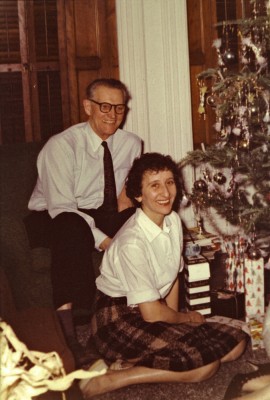 Tissa, after working at Paris based studios, entered New York animation in 1955 at UPA situated diagonally across from the Museum of Modern Art and John and Faith Hubley’s Storyboard, Inc. It was the right place for her.
Tissa, after working at Paris based studios, entered New York animation in 1955 at UPA situated diagonally across from the Museum of Modern Art and John and Faith Hubley’s Storyboard, Inc. It was the right place for her.
There had been few women animators in New York in past decades but, among the men, the held opinion was that women couldn’t do the job. There was also a general attitude that the craft was dominated by Americans. To them animation was a trade for which females and foreigners need not apply. UPA, however, was a progressive studio where the staff included various minorities and nationalities. As one talented African-American artist remarked, “When you walk in here you feel comfortable and welcomed.”
Tissa was greeted by animator Grim Natwick. His European art studies long behind him, he was the choice crew member to interview the then English challenged Tissa. Natwick was direct, ___________Tissa and Grim at Christmas
“What do you think of animation?”
Tissa hesitated , then replied, “Animation is animation.” That satisfied Natwick. Tissa was given a try out on a character from the studio’s popular Piel’s Beer commercials and then hired. The brief meeting with Grim was expressly important because the film that inspired her to get into animation was Disney’s Snow White and the Seven Dwarfs for which Natwick had animated 80% of the lead character. Tissa became Grim’s assistant beginning an association that lasted 35 years.
In time, Tissa became an animator in her own right at local studios giving life to TV commercials. Later came requests from producers with a broader range of diverse characters. These included John and Faith Hubley, R.O. Blechman and Michael Sporn all who came to depend on her animation skills and unique intellectual qualities. Tissa entered a legacy laid down by earlier European animators, illustrators and designers whose influence profoundly effected American cartoons. Working at Disney and Fleischer Studios, their affinity to old world castles, cottages and colorful personalities added credibility, charm and warmth to animated features.
Tissa also played an outstanding role in the ASIFA-East chapter. She organized and corralled the membership lists and dues collections. This was at a time when new graphics guilds were entering the field with lists of 2000 or more, but Tissa proudly managed our 250 or so enthusiatic members.
She was a prime promoter and facilitator of the ASIFA-East Film Festival, and tabulated the voting results as well as commanding the arranging of the event’s refreshment tables. Under her discriminating gaze many of us schlepped wine bottles and tubs of cheese.
I worked with Tissa at various studios around the city and remember a gratifying moment one rainy day when she and Grim came to one of my classes. They had gotten lost in SVA’s internal maze, arriving late and dripping wet. Though tardy, they added substance to the class by answering questions and giving weight to the realities of the field. To the familiar student concern about whether the character of Snow White was traced over live-action actors, Grim, chalk in hand, sketched Snow White to clearly illustrate why her cartooned proportions didn’t allow for rotoscoping.
There’s one anecdote regarding Tissa that I’ve repeated many times, but it still warms my heart, so pardon me if you’ve heard this before. I feel it’s worth repeating since it indicates Tissa’s warmth, humor and life-energizing spirit that rose above everyday twists and turns.
Tissa often traveled to Europe to see family and to animate for small studios. She also had a country house in Southern France. In the spring of 1974, while working in Holland, she contacted Iris and I about attending the animation festival in Zagreb. Her suggestion was that we meet her in Paris a week before the event. She kept a small Volks station wagon there and proposed that we drive across Europe to Zagreb. We accepted gladly. It would be a wonderful journey with a great guide. After a night in Paris we drove south through agrarian countryside evoking the colors of Van Gogh and other post impressionist painters. We stopped in a small town so Tissa could check out her French country place and then we found a small, inexpensive hotel for the night. Tissa suggested that Iris and I take a back room and she a front room. Our lodging was simple, but when we opened the shutters to let in the good night air, we saw the shining moon behind silhouetted castle towers. We slept soundly.
The next morning at breakfast we wondered if she had slept well. “Oh it was terrible!” she replied, “Big trucks rattling past my window all night!” We traveled on through southern France and into northern Italy. One late afternoon we arrived at a local hotel and prepared for a night’s rest before entering Venice. We agreed that this time Tissa would take a back room and we a front room. We slept soundly.
In the morning came our question,” How did you sleep?” It was terrible!” she replied, “There were people playing guitars and singing all night in the courtyard!”
Tissa David will be remembered as a person of taste, humor, artistic skills and a wide understanding of people and the world in general. She observed and interpreted things in a private way. She appreciated much but was opinionated and disdainful of things that didn’t meet her standards. Tissa was a dedicated animator on all manner of productions from workaday TV announcements to celebrated award winners. Though a very private person, she was a friend and mentor to many. She was a treasure in our midst. For all of us who knew and admired her, she will be missed.
Howard’s talk was followed by a clip from Raggedy Ann and Andy
her Candy Hearts and Paper Flowers sequence.
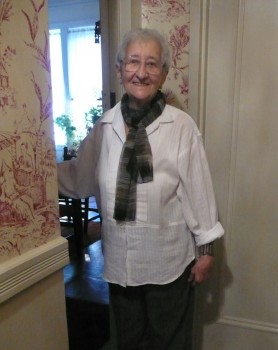 R.O. Blechman was the next speaker. His short talk was planned but spoken off the cuff, improvised. There’s no transcript of it.
R.O. Blechman was the next speaker. His short talk was planned but spoken off the cuff, improvised. There’s no transcript of it.
He started by quoting a poem Tissa liked by T.S.Elliott in which Tissa had substituted the word “animator” for “poet”. Bob also told the story of an article about his show Simple Gifts in which he called the 5 designers, “Artists.” Bob was surprised that Tissa had confronted him by telling him that she was an “Artist” yet there was no mention of her in the promotional article.
Bob’s talk was followed by clips from his studio:
3 commercials for:
– Perrier
– Banco
– WQXR radio
a clip from a promotional trailer for Candide, a film Bob sought to make as a feature.
a clip from The Soldier’s Tale, Blechman’s Emmy winning adaptation of Stravinsky’s work.
Candy Kugel was the next speaker.
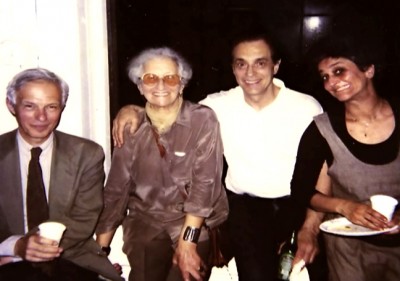 Tissa was my role model—a pathfinder. When I entered the animation industry in the 1970’s there were no other female animators beside her and I was experiencing the same sexist attitudes as she did. And I was in awe of her ability—her fluid line and acting. And finally, I was always grateful for her introduction__________(LtoR) Blechman, Tissa, Vince Cafarelli, Candy Kugel
Tissa was my role model—a pathfinder. When I entered the animation industry in the 1970’s there were no other female animators beside her and I was experiencing the same sexist attitudes as she did. And I was in awe of her ability—her fluid line and acting. And finally, I was always grateful for her introduction__________(LtoR) Blechman, Tissa, Vince Cafarelli, Candy Kugelto international animation and ASIFA.
The first time I was introduced to Tissa was on the telephone in the summer of 1972. I was about to go to Italy for my last year of art school after spending summers interning at Perpetual Motion Pictures.
My boss, the designer Hal Silvermintz, told me that Tissa knew everyone in Europe and she could give me the names of studios so that I could visit them while there. She did, and I did – in Rome, Zagreb and Budapest. And then, since Annecy would have its festival that June, she encouraged me to go and gave me the address to write for certification.
I did go to Annecy and it opened my eyes to international animation in a way I could never have imagined before. There was no internet then, no DVDs and no video collections—the only way you could see these movies was projected in a theater. And I do remember briefly meeting Grim Natwick (who drew me a Betty Boop) and Tissa.
When I returned to New York, it was a bad time for animation so I went to Los Angeles to try my luck there. In New York I had had the good fortune to be treated well by my bosses—my main responsibility was to help the designer.
I had some rudimentary animation experience, but the real animation was done by experienced animators, and they came from a culture of secrecy.
In LA I went to Disney with my “reel†and portfolio and found a whole other set of obstacles. The front gate passes had “Mr.†printed on the guest line. This was during the feminist movement and I jokingly said to the woman behind the window—“I guess you don’t see very many women hereâ€â€”she scratched off the Mr and roughly handed it back to me. I met with 3 men, including Don Duckwall. They told me I drew nicely but that women just don’t have what it takes to be an animator. Women lack timing. Maybe I should consider becoming a designer or background artist.
“But I want my drawings to ACT!†I protested. They smiled and shook their heads.
In the end, I returned to work fulltime at Perpetual. I was determined to learn how to animate well. I got to know Tissa through ASIFA and she offered to help me.
Perpetual picked up a project that had an incredibly low budget, so they gave it to me. Whatever I could manage would be enough. Vincent Cafarelli had recently started freelancing there, and although he was open to helping me, he encouraged me to seek out Tissa’s advice. They had worked together at UPA and he had great respect for her. He even told me I flipped like her.
Tissa invited me to her home and she demonstrated some things. And gave me homework. I went a few more times—I wish I could say that I was a stellar student, but I’m afraid her criticism, although completely deserved, was too biting for my fragile ego.
She was my idol—I loved her work – her beautiful line and her acting. I respected her immensely—but I think I must have been a great disappointment to her. At that time, I was the only girl working her way to become an animator in an established animation studio in NY. I imagine she was hoping for a protégé equal to her talents.
But even without the lessons we remained friends. She followed my career closely and we worked together in ASIFA.
We both understood the difficulty in working in a “man’s profession.†I was criticized by the ink and paint department for not being one of the girls—I was a guy because I used a pencil and not a brush. Outside of Perpetual there were animators and assistants who thought it wrong of me to take a man’s job. Some kiddingly said they would “break my fingers.â€
I admired Tissa even more, knowing exactly what she had been through.
But we never spoke about it after our first meeting at her apartment: I gingerly asked her about how she dealt with the male animators—their practical jokes, the macho culture–were there rumors about her and Grim? She looked at me harshly and waved her hand. Who needed to complain—it was just part of the job.
I will miss Tissa—her generous spirit, her biting wit and her talent. There are too few of them out there.
Candy’s talk was followed by clips from 3 films done for Michael Sporn Animation:
Lyle Lyle Crocodile
The Red Shoes
The Story of the Dancing Frog
Arlane Nelson was the next speaker.
- As Michael said, I am one of Tissa’s nieces. An interesting side note, Tissa was one of 10 children, 7 girls, 3 boys. In my generation, the next one, there were only a total of 3 girls among all the nieces and nephews.
I’d like to begin with an email one of my Hungarian cousins sent me:
“Tissa was known to love music, and we had talked a lot about our favorite performers: Horowitz, Goild, and many other artists. However one thing that is not common in elderly people, is to be open to new things, as Tissa had been. Once I saw a movie about the life of Manuel de Falla, which has a lot of music inserted, one even recorded during his short life. The recording is very interesting because when Falla wrote his masterpiece, El Amor Brujo, he wanted to reject it because the passion radiating from the piece is in total contrast with his deep catholic faith.
Manuel de Falla, just as Kodaly did, collected folk music, the music of the flamenco playing gypsies. El Amor Brujo totally gives back this surreal feeling. In the movie, in order for the illustration to be perfect, two songs, that are accompanied by a large orchestra, were sung by a young female gypsy singer with the technique typical to flamenco. The passion radiating from the recording is scary. I showed it to Tissa who said that this woman is like a storm. And she started telling me stories about being in Andalusia, listening to flamenco music, and how much she liked it.
The other memory is connected to flamenco as well. Many people think that they like this musical style, while they only meet the civilised versions. I have watched Saura’s movie, called Flamenco in which there is a part when two old gypsy men sit on a chair and sing without music. One of them has golden teeth, the other one has silver teeth. This is of course not singing according to European standards, this is rather some endless, sharp, painful, and aggressive shouting, confined among borders. As far as my experience goes, only a few can understand this deepness of art. Tissa understood it, we talked a lot about it later on, and she pointed out the complicated symbols in the text that I had missed on my own.â€
Anyway, I live in the Washington metropolitan area and as such, we used to see Tissa a lot; more than any of our other relatives. She’d be down to visit us several times a year and sometimes, we came up to visit her. I’d like to share a few of my memories of who Tissa was.
Growing up, we kind of knew that Tissa was a famous person and we were very proud of this. I can remember, when my sister and I were small and Tissa came to visit, we had to wait until the morning, but we would go charging in and have her tell us the latest Letterman shorts she had done. So we’d know the stories before anyone else did.
 Tissa loved cooking. Whenever she came to visit, she took over the kitchen; you entered at your own risk. Except for the dogs, who usually waited in endless vigil watching every step, every action with rapt attention for the treasures they knew would fall. One of the things I found__________Tissa cooking in her NY kitchen
Tissa loved cooking. Whenever she came to visit, she took over the kitchen; you entered at your own risk. Except for the dogs, who usually waited in endless vigil watching every step, every action with rapt attention for the treasures they knew would fall. One of the things I found__________Tissa cooking in her NY kitchen
inexplicable was her use of
cooking implements which would increase exponentially with availability. A dish she would make in her tiny kitchen might take 2 bowls and a pot. The same dish in our house, could take 7 bowls, 5 pots, and 3 pans. Any time you walked in to the kitchen, all burners would be going, some would even have two things on at the same time. A couple of things would be waiting on the side for a burner to free up, some other dishes would be done, there would be something at the chopping board in mid process, and usually a vegetable of some kind hanging out in a colander in the sink. Or trying to get a recipe from her was always a challenge. For example, when she was trying to explain how to make galuska to us: You started with a cup of flour and one egg. Then you added milk. Okay. So, how much? Well, as much as it takes so that if you stick a spoon straight up into the batter, it would fall over very slowly. There was another time I wanted to make Beigli for Christmas. Tissa said she would send me my aunt Dusi’s recipe because it was the best. Again, you started with 70 decagrams of flour, grated in some lemon rind and then sour cream. How much? Well, this time you had to add just enough so that the dough would behave when pinched like an old woman’s skin. Needless to say, without centuries of Hungarian cooking practices ingrained, whenever I did anything with Tissa, I ended up taking a novel’s worth of notes.
I remember once having a conversation with Tissa in which she quite definitively stated that it was a shame Scotsmen wore kilts as they had some of the ugliest knees in the world. I want to say that she thought the Germans or Dutch would have been better suited. Despite his having ugly knees, tho, Tissa admitted to a fondness for Sean Connery.
Tissa was also a very generous person. We were always welcome at her place as long as you did not mind the conditions. Anyone who was ever at her apartment knows it was rather small. But we would make it work. I remember one time when I was 8 or 9, there must have been 7 of us there. I can still see myself picking my way carefully across the floor of sleeping bodies to get to the bathroom. My children especially looked forward to our New York trips: the rules of living conditions were suspended and there were so many things to engage little minds. Then when my mother was sick, Tissa packed up and moved in for as long as it was going to take helping to take care of my mother so that she could have her wish of dying at home. It was this same wish of Tissa’s, I’m glad I had some part in returning.
Another thing that was important to Tissa was her faith. She always had this quiet, laid back, do what you are going do attitude. I always thought it was part of the reason she seemed so at peace with things, even her death. No matter what else happened or changed, Tissa had this. She was very different than my mother in this way. Tissa didn’t fly off the handle, or ram things down your throat, or sweat the small stuff. She knew what was important to her and the rest didn’t bother her. Tissa also was very adamant that my sister’s memorial marker have a cross. Despite my sister’s claims to atheism, Tissa was convinced that Tamar found redemption in the end.
Before I had children, I used to go to the movies every weekend, so, Tissa and I would compare notes on films we had seen. Very often, they would be showing in New York weeks before the artsy theaters in DC picked them up, so Tissa would let me know what to add to my list. However, we often found we had different sensibilities. One such film was The Triplets of Belleville. Tissa told me I had to see it: it was wonderful not only as an animated film but also for the story of the boy and his grandmother. After I saw it, I called Tissa and told her that yes, it had been a wonderful film, but she should have warned me about the frogs. Tissa paused a moment and then said “Oh, yes, the frogs. That was a very funny scene.†I responded “No, it wasn’t funny, it was tragic and you should have prepared me.â€
Tissa did not like technology, but accepted it as a necessary evil. However, she refused to take the time to understand how things worked. Many times when I came up to see her, Tissa would have some contraption that she needed me to install or set up: an answering machine, a VCR, an antenna, the HD receiver, a hand held sudoku game, etcetera. Once I was done tho, she didn’t want to know the details, just the buttons she needed to press. We tried for years to get her onto email, but she wouldn’t hear of it. There would be no computers, no cell phones, no tablets, nothing of that kind ever with Tissa.
The last time I brought my children up to see Tissa – at the end of July – you could see how happy it made her to sit and watch them play. She always enjoyed the children in her life, even after we thought we had grown up. She was kind and nurturing and a mother to us all. Whether she was teaching us, encouraging us, forming us, feeding us our favorite creamed spinach, or just loving us. She was an important fixture in all our lives and one we will make sure no one ever forgets.
Arlane’s talk was followed by a long clip from a film Tissa animated for me,
The Marzipan Pig.
My speech followed. It was the last of the evening. I gave it extemporaneously, and there is no transcript of it. I tried to be as funny as I could, and that worked. The following is the original speech I walked in with. It’s not good, bathetic and inapropriate for the final talk. My changes worked. To give an indication of the final, though, I’ve decided to leave this here.
Michael Sporn
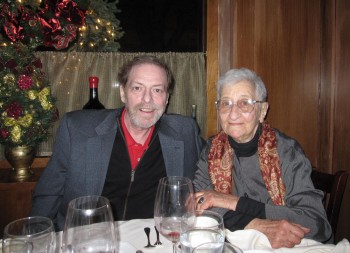 Forty years ago, on Tuesday Oct 10, 1972, 1 had just started my second day in animation working for John and Faith Hubley. I was scheduled to work three days to help finish a commercial. Helen Komar was the only other person working on that commercial with me. She was the production coordinator. My second day there, and I was working as intensely as 1 could. 1 loved being there, I was finally doing animation and getting paid for it.
Forty years ago, on Tuesday Oct 10, 1972, 1 had just started my second day in animation working for John and Faith Hubley. I was scheduled to work three days to help finish a commercial. Helen Komar was the only other person working on that commercial with me. She was the production coordinator. My second day there, and I was working as intensely as 1 could. 1 loved being there, I was finally doing animation and getting paid for it.
That day, 1 continued to work through my lunch break; I wanted to get it right. That’s when T heard this voice with a sharp Hungarian accent say loud enough, “Who has been doing such HORRIBLE inbetweens?” Sheepishly I looked up and had to admit that we all knew she was talking about me. Especially since I was the only one doing inbetweens. That’s how I met Tissa David.
Tissa proposed I come to take lessons from her; she would help teach me what she could about animation. This meant I spent a lot of time doing homework that Tissa would give me inbetweening over and over and over again animation drawings that were usually from a scene that Grim Natwick had animated. Back then, Tissa had a sharp way of telling you how bad you were. It didn’t take me long to find the humor in what she had to say, especially since 1 was even more of a critic of my own work than she was.
Things changed a bit over the years. Tissa grew more and more reserved with her opinions. She made an obvious attempt to moderate herself when she thought it was too harsh. However, I always tried to encourage her to fully express what she thought about my work, and I like to think she was honest with me throughout.
Somewhere along the line I stopped asking for help with animation. Slowly we became more friends rather than teacher and student. When she left the Hubley studio to work for Richard Williams on Raggedy Ann, knowing full well that I was a big fan
of Dick Williams’ work, she maneuvered a job for me on the production. Starting as an inbetweener, I worked my way up to the position of head of Assistants and Inbetweeners.
After that, I was hired by Bob Blechman to be his Asst Director working on a Christmas Special. Before we got to that we did a number of commercials together. Once Bob had difficulty finding an animator, and 11 talked loudly and enthusiastically about Tissa’s work. She soon started working with Bob in a relationship that lasted years.
When I formed my own studio, I directed a number of half hour shows. Tissa was happy to work for me in many capacities. She did storyboard, layout and sometimes animation. We helped each other often by just being there. That made a lot of the jobs more fun, and helped me feel even more proud of the work I was doing.
The last couple of years weren’t about animation, really. Yet the two of us were able to keep laughing throughout. And talking. Talking about museum shows and films that we saw. Sharing books we’d read or just sometimes talking. I was never much of a phone person so it had to be face on.
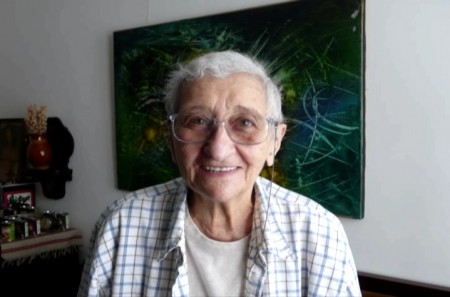
Tissa in her Living Room
Photo by Mate Hidvegi
In the end 1 learned that Tissa had developed a brain tumor. Of course, I didn’t know whether that meant she would have a long slow death or a quick one. 1 went one Saturday afternoon and laughed quite a bit with Tissa. When I brought up old names and places and events, she remembered them clearly. If she tried to remember something, she couldn’t, and the conversations would end flat. It meant I had to keep talking.
I left that afternoon and expected to return five days later. But that day I got a call from Susan Davis telling me that Tissa had died that day. She didn’t feel well in the morning, lay down for a while, and didn’t wake up.
I think her passing won’t really hit me for a while. I’ve been spending a lot of time editing this footage. Now this memorial is done, and I think the reality won’t hit home until Christmas. Every year, I’ve received a wonderful fruit cake from Tissa. In fact, I still have a couple unopened. I know that one won’t arrive this year, and I’ll miss my fruitcake this year.
This talk was followed by the last animation work Tissa did,
part of the animatic for my feature, POE.
.
.
 1
1
a 1942 drawing by Tissa’s close friend, artist,
Judit Reigl. The drawing is in the collection
of Tissa’s sister, Katalin David.
Thanks to Mate Hidvegi, Katalin’s son, for sending it.
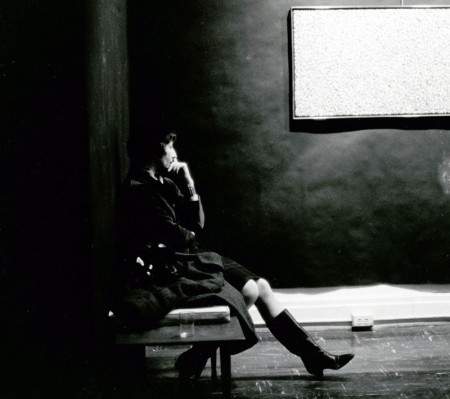 2
2
Tissa in an Art Gallery in the 60s
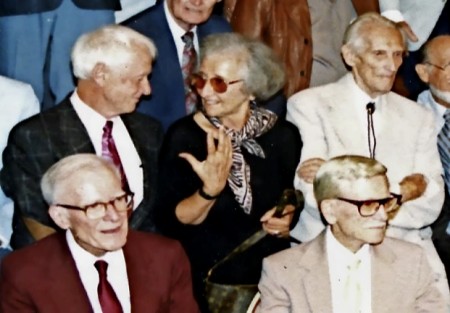 3
3
At Grim Natwick’s 100th birthday
(L to R) Duane Crowther, Tissa, Grim Natwick
in front of them: Frank Thomas, Virgil Ross
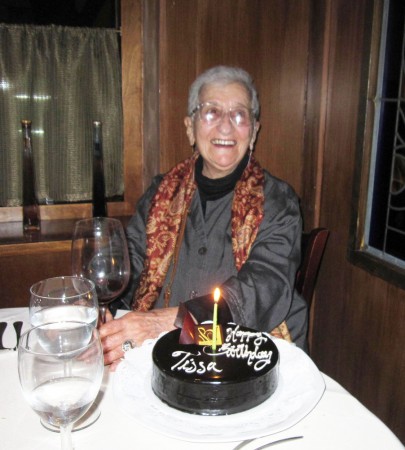 4
4
Tissa on her 90th birthday celebration dinner
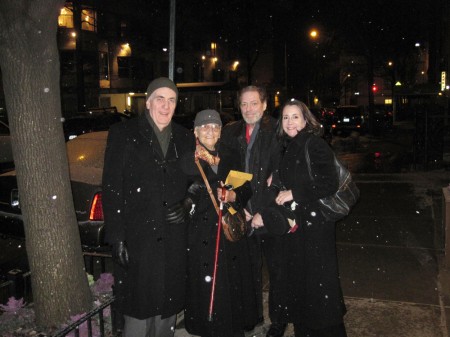 6
6
(L to R) John Canemaker, Tissa, Me, Heidi Stallings
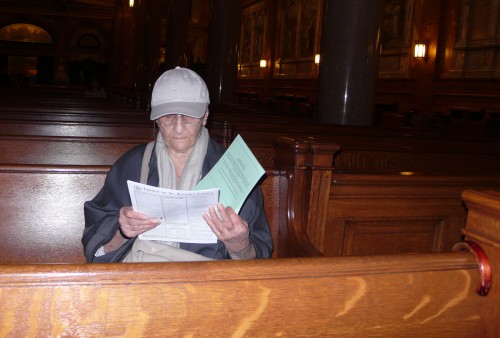 7
7
Tissa in St. Ignatius Loyola Church, 84th St, Madison Ave.
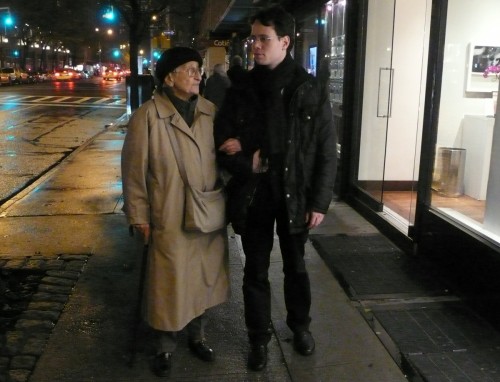 8
8
Tissa with Aron Hidvegi, her grand nephew
4, 5, & 6 photographed by Joe Kennedy
7, 8, 9, 11 & 12 photographed by Mate Hidvegi
10 photographed by Aron Hidvegi
Commentary &Daily post 03 Nov 2012 07:35 am
A Dully Exciting Week
It’s been a long week. The events of my week probably aren’t going to be too interesting to many of you, but it’ll be cathartic for me to write, so I will.
Monday brought the threat of a hurricane. I remember thinking that “Sandy” was not the best name for a hurricane; naturally, it would turn out to be one of the nastiest in my lifetime. Once again, as they had done with “Irene” they told us to prepare by buying duct tape, batteries and water. With “Irene” it was a waste of time;with “Sandy” it was a necessity. Actually, the best buy for us was one Heidi had done for “Irene.” All of the stores had sold out of flashlights, until she found one in a local hardware store. This was a huge thing that actually worked as one or broke into three separate flashlights. This item became a lifesaver a year later during the “Sandy” debacle.
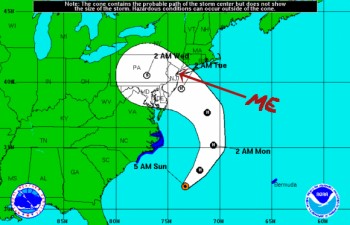 Monday night there was a robo-call from Con Edison. They threatened to possibly turn off the electricity as a precaution to preserve the system. It would enable them to start the system up all the more expeditiously when they could. The weather map they were showing on TV had the cone of the hurricane’s left turn, off the Atlantic and onto a land mass, happening south of NY near the Jersey Shore.
Monday night there was a robo-call from Con Edison. They threatened to possibly turn off the electricity as a precaution to preserve the system. It would enable them to start the system up all the more expeditiously when they could. The weather map they were showing on TV had the cone of the hurricane’s left turn, off the Atlantic and onto a land mass, happening south of NY near the Jersey Shore.
I’d been engrossed in my latest enthusiasm, the Presidential election. Things were close. Obama was leading in a couple of the key swing states by one or two – the lights went out. Everything. Silence.
Heidi pulled out our tri-part flashlight and we broke into three parts and moved it around the house as we lit candles. She had really prepared with books of matches and tiny tea candles. We placed enough around to keep a semblance of life alive visually in the apartment.
 - Tuesday early morning brought the loudest noises. Not much rain but a lot of wind. We soon came to realize that the no-electricity also meant no heat. It wasn’t freezing outside, but overnight it felt as though it were freezing inside. For the rest of the week we had to bundle under quilts and blankets wearing layers of sweatshirts. The cats were confused and visibly cold. They went into winter mode, sleeping on their paws on beds and blankets and near any heat they could find.
- Tuesday early morning brought the loudest noises. Not much rain but a lot of wind. We soon came to realize that the no-electricity also meant no heat. It wasn’t freezing outside, but overnight it felt as though it were freezing inside. For the rest of the week we had to bundle under quilts and blankets wearing layers of sweatshirts. The cats were confused and visibly cold. They went into winter mode, sleeping on their paws on beds and blankets and near any heat they could find.
I got up every morning to light the stove. It’s a gas stove but has an electric starter that lights the pilot for you. I had to get in there and light the pilot every time I wanted to get it going. I lit it and figured a way to manipulate the oven door into the open position so that heat would invade the apartment, raising the room temperature by 10°. Since I no longer had a toaster, I could also use the lit oven to toast my english muffin in the morning.
No internet. This is a problem. No Splog. I had prepared a couple, and they were ready to be posted. By calling my sister, who had power, I was able to arrange to post the next two blog posts. Anything beyond that, and I’d have to write additional material. Not easy without access to a computer. Lack of a computer was more serious for Heidi. She lived off her email conversations with the different theatrical groups she works for. They actually hire via email, and things were already sketchy for a number of her assignments in the upcoming week. But she needed to get to the email to find out. If school was cancelled for the kids in any given day, Heidi lost out on a couple of jobs and hundreds of dollars. They meted out the information slowly over the course of the week. She kept preparing for classes in case, and they were ultimately all cancelled all week long.
 We went out to see what it was like on the street. Our neighborhood was dead. ALL of the stores were closed (they couldn’t even operate their cash registers without electricity.) We wouldn’t be able to do laundry until the power came back. We walked the ten blocks in a nasty cold windy rain to the first open store, a Duane Reade pharmacy. I went to the rear near the pharmacy (which was closed) and sat in one of the chairs provided for those waiting for prescriptions. Heidi shopped to see if we needed anything. Ultimately, we left watching a couple of elderly women blocking the cashier aisle as they used the electric outlet to recharge their cel phones. The very young cashiers – maybe they were 16 – didn’t care. None of the Starbucks stores we saw were open that day. We’d thought we could always go to Starbucks to recharge Heidi’s cel. (I still don’t have one. Talk about being out of it.)
We went out to see what it was like on the street. Our neighborhood was dead. ALL of the stores were closed (they couldn’t even operate their cash registers without electricity.) We wouldn’t be able to do laundry until the power came back. We walked the ten blocks in a nasty cold windy rain to the first open store, a Duane Reade pharmacy. I went to the rear near the pharmacy (which was closed) and sat in one of the chairs provided for those waiting for prescriptions. Heidi shopped to see if we needed anything. Ultimately, we left watching a couple of elderly women blocking the cashier aisle as they used the electric outlet to recharge their cel phones. The very young cashiers – maybe they were 16 – didn’t care. None of the Starbucks stores we saw were open that day. We’d thought we could always go to Starbucks to recharge Heidi’s cel. (I still don’t have one. Talk about being out of it.)
There was an event on Tuesday evening. A film was to be screened at MoMA. A few phone calls and I wasn’t able to find out whether the event was still on. We’d need to somehow be entertained in the evening. Getting out of the dark house. The neighborhood was also dark. Couldn’t see the hand in front of your face on the sidewalk. One of those flashlights was helpful to carry with you. It took until Wednesday for officials to realize they had to position a cop with flares at all the corners to direct traffic and avoid accidents. It was really dangerous for the pedestrians trying to get across the black streets. When I couldn’t get through via phone to MoMA, I decided to give up on a 20 block walk when I wasn’t sure if the film would be screened. We stayed in.
I called John Canemaker that evening. We had phones, as a matter of fact most people had phones. However, if the phones depended on electricity, they wouldn’t work. Fortunately, we had an old phone with a dial on it – no buttons to press – you turn the dial for each number. That worked. He had phones, heat, electricity and the internet. He invited us up to use his computer to check our emails.
Wednesday we had a game plan. I aimed for John’s apartment about 45 blocks away. Some buses were in operation for the first time. The rides were gratis, thanks to the City. However, there were fifty people waiting at every bus stop, and any bus that arrived was packed. Where there’s a will, there’s a way, and we got on a bus. It took about 30 minutes to go from 30th St to 42nd St. Heidi got off to go to the office at the New Victory Theater. They told her she could pick up some material she needed and she could use their computers if she needed one. She realized it’d take forever to get to 70th St to see John and Joe, and she had to do a bit of work and still get home in time to meet me to head up to SONY to see a film that evening. 6:00 cocktail/6:30 screening of Amour.
It took another hour for me to get to John’s apartment. Slow going. I could’ve walked there quicker. We had a nice, friendly chat. I posted something for the blog that said I’d have to freeze the thing until power returned, and I went through some of my email. John & Joe were taking in some friends who were lacking all utilities and couldn’t even shower. Nice of them; as John said, “That’s what friends do.”
It took forever to get to SONY on 55th Street. The bus crawled. We ditched it at 42nd street and walked the rest of the way. 1/3 the trip by bus = 45 minutes. 2/3 of the trip on foot = 15 minutes. We sat with Josh Mostel and laughed. He pointed out that there was no difference for him on the Upper West Side. With all his windows closed, he wouldn’t have known that a disaster had struck had he not seen the TV reports. Rain was light despite the fact that waves of water sunk the lower tip of Manhattan under the Hudson. I always knew how lucky we were to be only short of electricity. Here I was at a free movie with a cocktail and no thoughts whatsoever of complaining about my “plight”.
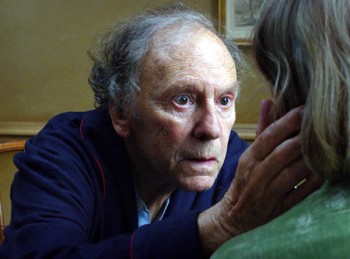 Amour was one of the best films of the year. It was directed by the German film maker, Michael Haneke, who had been nominated last year for The White Ribbon. His style is stark and direct and purposefully staid. Amour is the better of the two films, in my opinion, and the reason is Jean-Louis Trintignant, who gives one of his best performances and certainly the best performance of the year. He is brilliant and he is the reason not only to see the film but for the film’s existence. It is amazing in its stillness. Emmanuelle Riva is also excellent as his wife, heading full into a steady downfall via Alzheimer’s disease. I want to see the movie again, certainly. I’ve thought about it the rest of the week.
Amour was one of the best films of the year. It was directed by the German film maker, Michael Haneke, who had been nominated last year for The White Ribbon. His style is stark and direct and purposefully staid. Amour is the better of the two films, in my opinion, and the reason is Jean-Louis Trintignant, who gives one of his best performances and certainly the best performance of the year. He is brilliant and he is the reason not only to see the film but for the film’s existence. It is amazing in its stillness. Emmanuelle Riva is also excellent as his wife, heading full into a steady downfall via Alzheimer’s disease. I want to see the movie again, certainly. I’ve thought about it the rest of the week.
Heidi and I walked home in the dark. We had a lot to talk about.
Thursday was more of the same. I began by sketching for an animatic I’m trying to put together to show HBO. I’m trying to sell them on an idea about chemotherapy – not Cancer, but chemotherapy. It’ll be a documentary about some people who were touched by the “cure”. I’m sure HBO won’t buy it, but I’ve got to present it. I’ve recorded some of the voice work and am offering a couple of sections via animatic so they’ll know what I want to do. I’ve decided to sketch it out with pen and pencil and not draw it on computer. Who knows if that’ll mean anything once I’m into it.
I had a few chores to do; Heidi wanted to get back to the New Victory Theater. There were a couple of films scheduled to play at the Academy theater. I’d seen the second but thought I’d go to the documentary screening first. It was something about the decline of Detroit, and sounded as though it might be interesting. I phoned Candy Kugel and talked her into going. It’d be nice to say hi. Heidi couldn’t make it. She’d be working until 7:30. The plan was for us to meet after the film and her job; then we’d go to a diner near the theater and come home from there. It’d keep us out of the black apartment until it we had to.
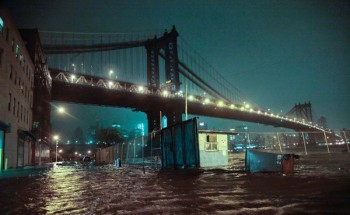 I left the apartment at 5:00 to walk to the screening. However, I realized that I’d left some candles burning and had to go beck to put them out. I didn’t want to return home to a burned-out apartment after the cats had knocked over a candle. As I entered the apartment the phone was ringing. It was John Fahr of the Academy to tell me that the projectionist couldn’t get in, and the screening was cancelled. Candy had gotten there very early and John had sent out an email, but Candy said I was without the internet, and she knew I was coming. So he called; nice of him. If I hadn’t returned, I’d have made it to the screening in time but would have to sit around for 90 minutes so I could meet Heidi.
I left the apartment at 5:00 to walk to the screening. However, I realized that I’d left some candles burning and had to go beck to put them out. I didn’t want to return home to a burned-out apartment after the cats had knocked over a candle. As I entered the apartment the phone was ringing. It was John Fahr of the Academy to tell me that the projectionist couldn’t get in, and the screening was cancelled. Candy had gotten there very early and John had sent out an email, but Candy said I was without the internet, and she knew I was coming. So he called; nice of him. If I hadn’t returned, I’d have made it to the screening in time but would have to sit around for 90 minutes so I could meet Heidi.
Instead, I got to stay home and continue reading a great book, Alan Bennett’s Untold Stories. Then I went uptown in time to meet for dinner and walk back home. It was getting trying. Once you cross 39th Street heading downtown, all the lights are gone. Pitch blackness. I can’t take much more of this.
We got home. The candles, the flashlight, the oven to warm the place before we went to bed, feed the cats and stop them from killing each other. I sketched until 3am. Dark at night or in the day, what was the difference?
Friday was more of the same, but the lights came on at 8pm. I got to catch Chris Matthews and Rachel Maddow. The polls were distinctly proObama. Here comes the weekend.
For Your Consideration
 - On Tuesday I’d posted all of the titles to those films which had passed the requirements to be eligible to compete for the Oscar for Best Animated Short Film. A few years back when I had done this, I’d received a number of letters from the Academy telling me that I was violating some rule or other. Actually, I think the violation was that I’d made a comment or three as I’m wont to do. That’s verboten and I was threatened that I might lose ©2012 MPAA
- On Tuesday I’d posted all of the titles to those films which had passed the requirements to be eligible to compete for the Oscar for Best Animated Short Film. A few years back when I had done this, I’d received a number of letters from the Academy telling me that I was violating some rule or other. Actually, I think the violation was that I’d made a comment or three as I’m wont to do. That’s verboten and I was threatened that I might lose ©2012 MPAA
membership if I didn’t behave. The next year
the titles were released on Cartoon Brew, then the Academy officially released the titles.
Maybe I helped change a rule.
This year I released the titles with some apprehension, but I didn’t really make any comments about the films. I just named some films that stood out in my mind. I don’t necessarily like all of those films, but for some reason or other they did stand out in my memory.
A few of the film makers contacted me afterward to get my opinion or advice about their shorts. All I could do was congratulate them all for having gotten to this point. It is exciting. The prospect of a nomination is a thrill that I lived through a couple of times, and one time I was actually nominated.
I wish them all luck. Let’s hope the ones with the big budget advertising campaigns don’t affect the judgements on the that have enormous ad campaigns behind them to tell us all how good these films are. They’ve all entered the twilight zone.
Another Sort of Campaign
- Mark Sonntag has begun another sort of campaign. Bounty Hunter Bunny is an animated film Mark is looking to make, and he’s set up an Indiegogo campaign to raise $10,000 for it. He has also set up a blog for the film; Bounty Hunter Bunny, the blog.
 Mark is an accomplished animator working out of Australia. He started early, making films on super 8mm at age 14 and has been in the business forever. Everything from Ren and Stimpy to The King and I has passed through his pencil, and he also has one of the finest blogs out there. Tagtoonz is pure animation history and a must-stop for those interested in animation’s past.
Mark is an accomplished animator working out of Australia. He started early, making films on super 8mm at age 14 and has been in the business forever. Everything from Ren and Stimpy to The King and I has passed through his pencil, and he also has one of the finest blogs out there. Tagtoonz is pure animation history and a must-stop for those interested in animation’s past.
It’s a cgi film that I feel confident in supporting. I’d encourage you at least to view the animatic on display; it’s really promising.
Go to: Bounty Hunter Bunny
The models look smart and the storyboard is exceptional. I like how he’s used the style to make the cg art look like rendered 2D. It’s very nice.
Good luck, Mark.
Commentary 30 Oct 2012 12:16 pm
Oscar Shorts
The following is a list of films that were screened as competing for the Oscar in the animated shorts category. The first half of the films were shown on Saturday, the second half on a Sunday. 6 1/2 hrs each day. Only for the hard of hearts who can make it. It’s like attending an animation festival compressed into two days. They treat us in a grand way in New York. Patrick Harrison and John Fahr really have it down and are wonderfully organized.
A quick scan (and I do mean quick) and I selected some the films that were more interesting to me than others. Of course, it’s hard to remember the films by title. When you see so many films in the dark, you have a hard time even remembering the titles, never mind trying to remember the films. Some stood out more quickly than others. None of the filmmakers’ names are on any of the material handed out to us, just the title, film times and film formats.
1. Dell’ Ammazzare Il Maiale – 6mins
2. Here and the Great Elsewhere 14mins
3. Amazonia 5mins
4. Being Bradford Dillman 10 mins
5. Belly 7 mins
6. Body Memory (Keha Ma’I LI) 10 mins
7. Cadaver 7 mins
 8. Combustible 13 mins
8. Combustible 13 mins
9. Dripped 8 mins
10. The Eagleman Stag
___9 mins
11. The Fall of the House
___of Usher 17 mins
12. Fear of Flying 9 mins
13. Fresh Guacamole
___2 mins
14. The Game 5 mins
15. The Gruffalo’s Child 26 mins_________________Combustible by Katsuhiro Otomo
16. Head Over Heels 10 mins
17. House of Monsters 7 mins
18. I Hate You Red Light 8 mins
19. I Saw Mice Burying a Cat 6 mins
20. Junkyard 18 mins
21. Kubla Khan 4 mins
22. La Detente 9 mins
23. Lost and Found 4 mins
24. The Making of Longbird 15 mins
25. The Missing Key 30 mins
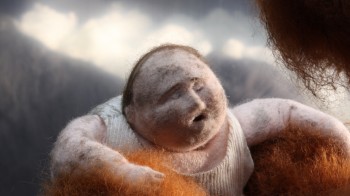 26. Oh Willy… 17 mins
26. Oh Willy… 17 mins
27. Pepe & Lucas 7 mins
28. The Pub 8 mins
29. Reflexion 4 mins
30. Slow Derek 8 mins
31. The Story of Pines
___16 mins
32. Tram 7 mins
33. The Wind Girl (La Nina de Viento) 14 mins
34. Wolf Dog Tales
___7 mins
35. Zeinek Gehiago Iraun
___12 mins ___________________Oh Willy by Emma De Swaef & Marc James Roels
36. 7596 Frames 5 mins
37. The Hybrid U-nion 5 mins
38. The Maker 6 mins
39. Paperman 7 mins
 40. Adam and Dog
40. Adam and Dog
___16 mins
41. Chase 13 mins
42. Kara 7 mins
43. Pasteurized 8 mins
44. Sammy 10 mins
45. Shift 5 mins
46. The Tale of a String
___ 8 mins
47. Wiggle Room 8 mins
48. It’s Such a Beautiful
___Day 23 mins
49. Overcast 9 mins _______________________Adam and Dog by Minkyu Lee
50. Traces 7 mins
51. Bydlo 9 mins
52. Kali the Little Vampire 9 mins
53. The Last Bus (Posledny Autobus) 15 mins
55. Edmond Was a Donkey 15 mins
56. Daffy’s Rhapsody 4 mins
57. Maggie Simpson in “The Longest Daycare” 5 mins
I don’t really have much information about the films or the film makers. However if you go to google and type in the title something should come up which will give you a lot of back information about the films and their creators. Worth the effort. For example type in “Oh Willy” and you get a whole series of photos and information about the puppet shoot etc.
Bill Benzon on Tissa’s Memorial
On his blog, New Savannah, Bill Benzon has written an excellent piece entitled What I Learned from Tissa David. The piece speaks about an animator’s style and how seeing a compressed number of films with the voice of the animator so obviously front and center helps allow us to recognize that voice. This, I have to say, is made easier by someone like Tissa who speaks so articulately through the visual emotions her characters display on screen.
Tissa gave every director a gift: deep and rich characters that spoke through their body language even more clearly than they could through verbalizing. Perhaps because Tissa had a bit of a problem with her speech (once a Hungarian, always a Hungarian) she was able to give her characters more communicative skills with their movements than they had with their language. This was something of a treat for me. In the final project she was doing for me, Tissa was working with highly articulate characters in POE, and adding the body language was giving the characters an amazing richness that is hard to express. Edgar Allan Poe was developing as an introverted character who lashed out and railed wen he spoke. All those words were spoken through a violent frustration that the character would have preferred not to vocalize. He always had to go in before he could lash out.
Art Art &Books &Commentary &Illustration 29 Oct 2012 06:21 am
Crumb’s Mighty Genesis
- Tsunami’s in Hawaii and Northern california, Hurricanes in New York and the Northeast. Floods everywhere. I see only one responsible thing to post at this point. Mitt denies the science of globl warming. Obama doesn’t fein stupidity but hasn’t done anything abot it. Not that his moronic Congress would allow him to take even a baby step.
In 2009 a book came out containing the appropriate chapter and artwork and response to our current dilemma.
Robert Crumb‘s Complete Book of Genesis.
His fantastic illustrations pull you into the book, and his condensation of the stories of the Old Testament couldn’t be better. If you don’t know about this Crumb book (and it’s hard to imagine that you don’t) you should get to a library or Amazon and buy a copy. It’s a grand work of Art, in my opinion.
Noah’s Ark, illustrated here in fewer than seven pages, gives a good sampling of what Mr. Crumb is doing with the work and deals with our modern problems.
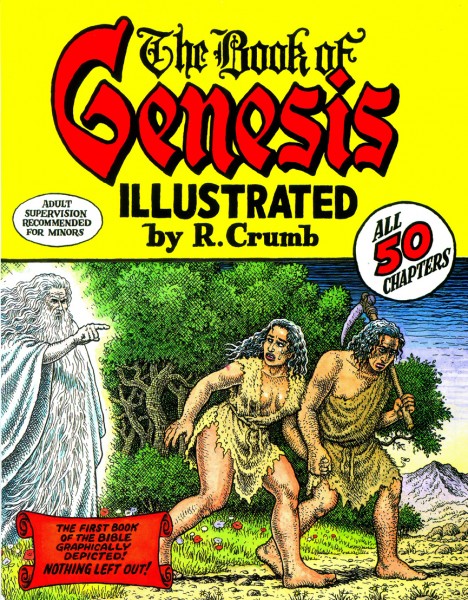
The Front Dustcover of the book
